

CH AN GE MAKERS

Phi Theta Kappa Mission
The mission of Phi Theta Kappa Honor Society is to recognize academic achievement of college students and to provide opportunities for them to grow as scholars and leaders.
About Phi Theta Kappa
Phi Theta Kappa is the premier honor society recognizing the academic achievement of students at associate degree-granting colleges and helping them grow as scholars and leaders. The Society is made up of more than 4.3 million members and nearly 1,300 chapters in 11 countries.
Publisher Phi Theta Kappa Honor Society, Inc.
Editor Jennifer Stanford Senior Director of Student Leadership
Production Staff
Tracee Walker Senior Director of Student Experience
Makayla Steede Creative Content Manager
Phi Theta Kappa Honor Society
International Headquarters | 1625 Eastover Drive, Jackson, MS 39211 ptk.org | 601.984.3504
Lori Brechtel Creative Designer
Phi Theta Kappa is committed to the elimination of unlawful discrimination in connection with all employment relationships, business operations, and programs. Discrimination based on gender, family or marital status, race, color, national origin, military of veteran status, economic status, ethnic background, sexual orientation, gender identity, transgender status, genetic information or history, age, disability, political affiliation, and cultural and religious backgrounds is prohibited.
@2025 by Phi Theta Kappa, Inc., in the United States and Canada. All rights reserved. No part of this publication may be reproduced without the consent of Phi Theta Kappa. The name, logo, and various titles herein have been registered with the U.S. Patent and Trademark Office. Change Makers: Phi Theta Kappa Journal of Student Leadership is published annually by Phi Theta Kappa, 1625 Eastover Drive, Jackson, MS 39211, 601.984.3504.
32 Health and Wealth: Preparing Students for a Balanced Future
Rho Kappa Chapter
Elgin Community College
Elgin, Illinois
36
Picture Yourself as a Pro:
Professional Development for College Students
Gamma Nu Chapter
Mississippi Gulf Coast Community CollegePerkinston
Perkinston, Mississippi
40 The Roller Coaster Ride of Mental Health: Free Virtual Counseling for Every Twist and Turn
Alpha Delta Omega Chapter
Glen Oaks Community College Centreville, Michigan
44 Making the Most of Calhoun: A Student’s Guide to Campus
Sigma Lambda Chapter
Calhoun Community College
Decatur and Huntsville, Alabama
47 Green Minds: Students Feeding the Future
Iota Xi Chapter
UCNJ Union College of Union County, NJ Cranford, New Jersey
51
Assessing Demand for On-Campus Drop-In Childcare Services
Beta Gamma Pi Chapter Yavapai College Prescott, Arizona
54
Shaping Student Leaders for a Brighter Future
Psi Psi Chapter
Brazosport College Lake Jackson, Texas
58 Increasing AI Literacy Among Community College Students
Beta Theta Kappa Chapter Butte College Oroville, California
61 Serving Our Students Through Sexual Health Education and Free Safe Sex Supplies
Alpha Beta Iota Chapter
Walters State Community College
Morristown, Tennessee
A Letter from the Editor
Welcome to the latest edition of Change Makers: Phi Theta Kappa’s Journal of Student Leadership. In this issue, we’re excited to share the amazing work of Phi Theta Kappa members who are making a real difference on their campuses and beyond.
This edition highlights a selection of award-winning College Projects from 2024. After reviewing more than 450 submissions, we’re proud to feature 15 projects that truly stand out. These projects reflect the creativity and impact of PTK chapters as they work with their colleges to tackle important challenges.
The College Project is a key part of Phi Theta Kappa’s mission to empower students to lead and serve. By aligning their projects with their college’s goals, PTK members team up with college leaders to create meaningful change that lasts. It’s a partnership that helps keep PTK chapters strong, connected, and impactful.
Each of the projects in this issue demonstrates what student leadership is all about. From mental health initiatives and strategies to improve student retention, to new ways of addressing campus health and wellness, these projects show the power of students to create positive change.
We hope these stories inspire students everywhere to take action and realize that they, too, can be the change their communities need.
With gratitude,

Jennifer Stanford Senior Director of Student Leadership Phi Theta Kappa Honor Society
About the College Project
The Phi Theta Kappa College Project is designed to engage students in leadership and service activities that support their college’s mission and build positive relationships with the college administration. The process of completing the College Project fosters student growth and helps fulfill our mission to provide college students with opportunities to grow as scholars and leaders.
Learning Outcomes
Planning, developing, and implementing a College Project contributes to personal, professional, and soft-skill development. It also allows students to have a meaningful impact on their college campuses by creating projects that support the institution’s mission. Members involved in the development and implementation of a College Project will be able to:
1. Design, organize, and implement a plan of action that results in a project that supports their college’s mission.
2. Demonstrate leadership, critical thinking, problem-solving, and reflective skills throughout the project process.
3. Form and lead teams that collaborate effectively with college administrators to determine and carry out an appropriate project.
4. Engage in professional written and verbal communication.
5. Provide evidence of project impact using quantitative and qualitative assessments.
6. Compile a report that communicates the project’s outcomes with clear, accurate, and effective language.
Achieving these learning outcomes helps students build the analytical, collaborative, and leadership skills that are essential for success in academic, professional, and community environments.
Editorial Board
The Change Makers Editorial Board is comprised of officers of Phi Theta Kappa’s Association of Chapter Advisors (ACA). The ACA board includes four ACA officers, one from each of Phi Theta Kappa’s four divisions. ACA officers are responsible for providing feedback to Phi Theta Kappa Headquarters staff on a variety of Society programs and priorities. The ACA board is made up of Phi Theta Kappa chapter advisors. ACA officers are nominated and elected by fellow Phi Theta Kappa advisors.
Mathew Herrman
ACA Chair
Representing Division III
University of Arkansas Community College at Morrilton Morrilton, Arkansas
Madelyn Bowman
ACA Vice Chair
Representing Division II
Tarrant County College - South Fort Worth, Texas
Dr. Sandra Rath
ACA Secretary
Representing Division IV
Central Arizona College - SanTan San Tan Valley, Arizona
Dr. Annie Tuttle
ACA Immediate Past Chair
Representing Division I
Onondaga Community College Syracuse, New York
Opioid Overdose and Prevention: Student-Led Narcan Distribution
Beta Mu Gamma Chapter
Solano Community College Fairfield, California
Abstract
The risk of opioid exposure, including fentanyl, on college campuses is significant, and it directly impacts the college’s capacity to deliver its mission. Opioid exposure and overdose are an on-the-ground reality for colleges. Importantly, there are actions a college may take to address the realities of opioid exposure in support of its students and college mission; these actions may include providing the campus community with educational resources and access to harm-reduction programs, including the distribution of Narcan/Naloxone.
According to the California Department of Public Health, of the 9,634 overdose deaths in California (August 2023 to August 2024), 63% were due to opioids (59% due to synthetic opioids such as fentanyl). Fourteen percent of college students in the United States report misusing prescription opioids. And half of college students in the U.S. report they can easily procure illicit opioids. In contrast, overdose deaths in the U.S. have dropped 10% since April 2024, largely due to harm-reduction programs that make life-saving treatments like Narcan/Naloxone available.
In collaboration with our college superintendentpresident, members discussed how the college might better address the impact of opioids and the fentanyl crisis—an important step to providing equitable access to the goals of the college mission. The superintendentpresident directed our chapter to design a project to address opioid overdose, with an emphasis on preventative measures, including the exploration of Narcan/Naloxone distribution.
With administrative and faculty support, our chapter held the event, Opioid Overdose and Prevention: StudentLed Narcan Distribution, for forty-eight students, faculty, administration, and college trustees. The event included background and statistical information, direction on the symptoms of opioid overdose, and a demonstration of how to administer Narcan/Naloxone.
Members trained by EMT faculty then provided smallgroup instruction for participants to practice Narcan/ Naloxone administration. The chapter distributed Narcan/Naloxone to all participants.
As a result, participating students, faculty, and administrators are positioned to save lives in moments of crisis, supporting students and their communities in alignment with the college mission.
Planning
In August 2024, members prepared for their conversation with the superintendent-president through a review and discussion of the college mission statement. Members focused on key elements of the mission, including “to educate a culturally and academically diverse student population drawn from our local communities” and the delivery of diverse programs, degrees and certificates, and “lifelong learning opportunities.”
The superintendent-president consulted with members and shared that support of the college mission included proactively addressing obstacles to student success in and outside the classroom. The superintendent-president emphasized the fentanyl crisis and its impact on access to the college, as well as student success, safety, and support—key requirements for achieving the college mission.
Discussion centered on the opioid epidemic’s impact on the equitable delivery of the college mission. Members and the superintendent-president focused on the impact of fentanyl on students, their families, and their communities. Members shared personal experiences, feelings of helplessness, and concerns for their peers. Participants discussed how to deliver meaningful impact to support students, staff, and faculty through preventative action.
The superintendent-president directed the chapter to design a project to address opioid overdose with an emphasis on preventative measures, including the exploration of making Narcan/Naloxone available to the campus community. The following objectives were identified:
• To work collaboratively with EMT faculty to deliver information on opioids
• To explore mechanisms to provide Narcan/ Naloxone
• To create an event open to students, staff, and community members
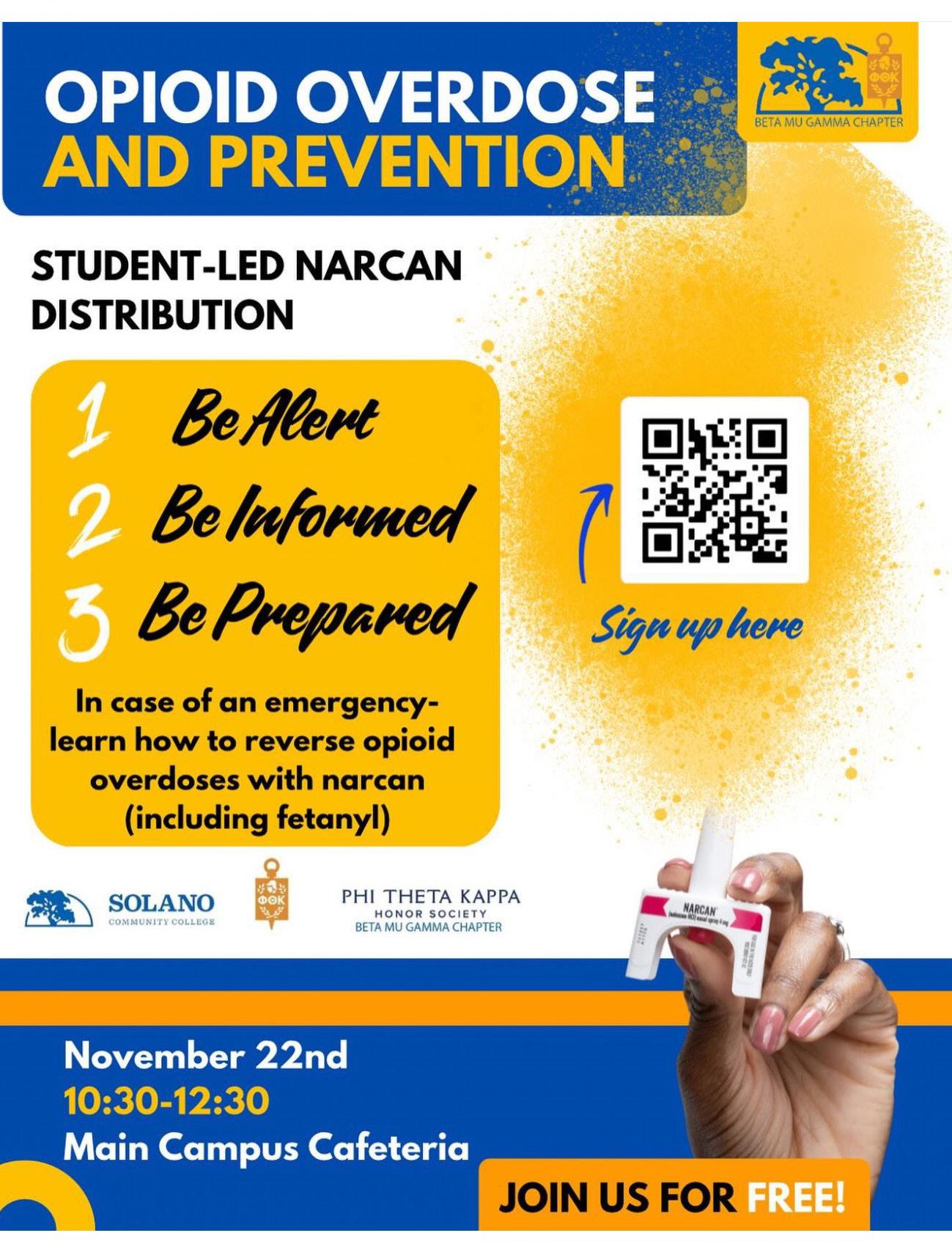
To determine the event’s scope and focus, the chapter explored access to Narcan/Naloxone. They identified resources through the Naloxone Distribution Project (NDP), made available by California’s Department of Health Care Services. The chapter submitted a successful application through the NDP online portal for 112 units (two doses per unit) of Narcan/Naloxone for distribution. The chapter developed an online survey tool to document administration of doses, as required by the NDP.
College administration approved the chapter event, Opioid Overdose and Prevention: StudentLed Narcan Distribution, with the goal of hosting seventy-five participants to deliver information regarding opioid overdose and direction on how to administer Narcan/Naloxone. Attendees of the event would receive informational tools and be provided with Narcan/Naloxone in case of emergency. Attendees would be apprised of how these preventative measures supported the college’s mission of equitable access.
Figure 1
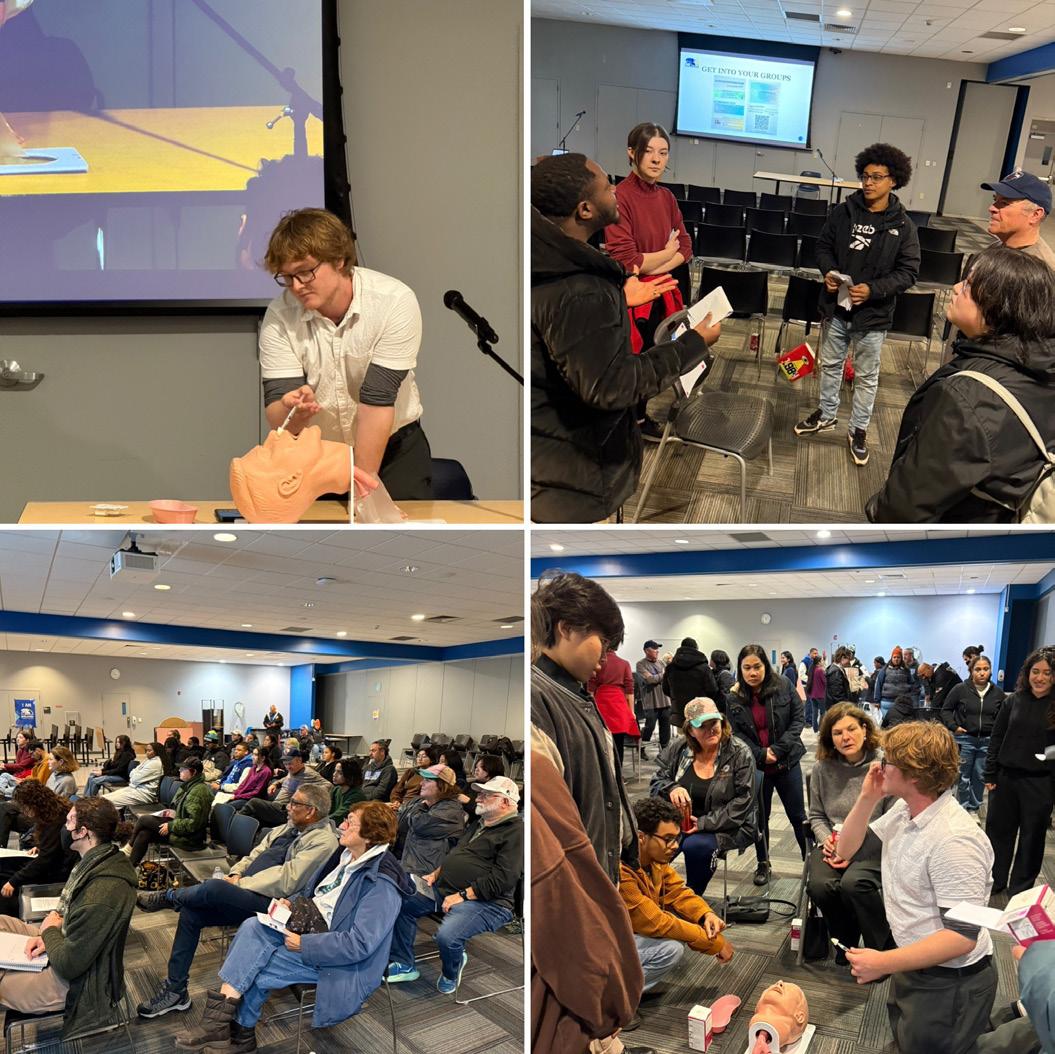
Leadership Development
Members developed leadership and communication skills to promote the event. Key members with course experience in graphic design developed and led a branding campaign. To promote a strong message, members brainstormed and refined language and design components. Members who are veterans and/or who study diverse medical fields shared their perspectives on positive messaging. The result was language and imagery designed to invite participation without overwhelming or intimidating would-be participants.
Promotion required collaboration with campus promotions and the Basic Needs Center. Members benefitted from exposure to diverse on-campus media sources, including digital announcements to all students via the college’s learning management system, college and chapter social media, and widely dispersed flyers/posters, which allowed for digital registration via QR code (Figure 1). Promotion included an online RSVP system.
Members collaborated with active college clubs, college faculty, administrative staff, and college promotions to develop and promote the event. Representative members also developed, practiced, and led multiple presentations for core representative bodies, including Interclub Council, Student Government, Academic Senate, Shared Governance
Council, and the Trustees of the Governing Board. Each group was provided with resources and advertising materials for their respective constituencies.
Our chapter collaborated with EMT faculty to train members according to three outcomes: how to identify symptoms of opioid overdose; how to administer Narcan/Naloxone; and how to solicit intervention from emergency responders. EMT faculty administered this training to nineteen members, each of whom would co-facilitate the on-campus event.
Members led the planning of the event, including research, material design, and presentation planning and practice. The chapter developed and/or procured training materials for the event, including a slide presentation, supporting materials, and medical dummies for practice and demonstration. Members held a mock training session to practice. They also worked with on-campus facilities and IT to prepare for and set up the event.
Collaboration
Opioid Overdose and Prevention: Student-Led Narcan Distribution hosted forty-eight participants, including students, staff, faculty, administration, and a college governing board trustee (Figure 2). The chapter designed and facilitated a three-part program.
Part One included background and statistical information, direction on the symptoms of opioid overdose, and a demonstration of the administration of Narcan/Naloxone. Chapter members discussed the importance of understanding the opioid crisis, with emphasis on fentanyl. Statistical evidence showcased its relevance to college campuses in our state and across the nation. Also explained were indicators of opioid overdose and how to respond, including contacting emergency services and a demonstration of Narcan/Naloxone administration on a medical dummy. An opioid fact sheet (Figure 3) and a walletsized card outlining these steps were provided to all participants.
Part Two divided participants into groups of four to five individuals to practice Narcan/Naloxone administration under the guidance of our trained members. Participants practiced using medical dummies provided by our EMT program. Members facilitated instruction on recognizing opioid symptoms and administering Narcan/Naloxone.
Figure 2

Part Three included the distribution of Narcan/ Naloxone to all participants and instruction on how to use the online survey for tracking purposes. Each participant received a free box containing two doses and a QR code to the reporting mechanism should the doses be administered.
Members closed the event with time for follow-up questions, emphasizing the benefits of community action in support of the college mission.
Impact
Quantitative measures included the number of attendees and the number of boxes of Narcan/ Naloxone delivered to our community. Nineteen chapter members were trained to present substantive guidance on its administration. The event supported forty-eight participants, and just over fifty multi-dose boxes of Narcan/Naloxone were distributed.
Qualitatively, members practiced skills in planning, organization, and presentation. They worked collaboratively with peers in other clubs, as well as faculty and administrators across campus. Members practiced co-facilitating a large event and collaborated with diverse groups to demonstrate and instruct. Members also learned to reframe a sense of helplessness—sometimes accompanied by personal experience and/or trauma—by delivering
meaningful and life-saving skills to benefit their college community.
Moreover, the success of this event can be measured in its next steps. One trustee of the Governing Board requested that the event be replicated at a regular board meeting in 2025. Also in 2025, our chapter has been invited to present to EOPS, Counseling, and at the community library. One immediate goal is to distribute the remaining boxes of Narcan/Naloxone.
The chapter has also been asked to work directly with the college’s Basic Needs Center and Department of Public Safety to increase the availability of Narcan/ Naloxone on campus.
Chapter–College Relationship
This is the first College Project developed in collaboration with our new superintendent-president and served as a powerful introduction of our chapter and PTK to college leadership. This project created a clear bond between the chapter and the office of the superintendent-president. Our chapter also shared information with various administrative groups, including the College Governance Council and the Trustees of the Governing Board. The success of these relationships is reflected in their willingness to support and participate in the event, as well as in their requests for the chapter to continue this work through future workshops and presentations.
Figure 3
Implementing a PTK CCsmart Student Recruitment and Retention Team
Alpha Tau Zeta Chapter
Athens Technical College
Athens, Georgia
Abstract
The “Excellence in Academics and Service” initiative is a PTK College Project developed in collaboration with the college to advocate for the benefits offered by the two-year college. Our program, dedicated to empowering students in meaningful ways, reflects PTK’s commitment to supporting the college’s mission of promoting lifelong learning and prioritizing initiatives that enable students to make informed decisions about their futures.
Our joint goal is to reshape the conversation surrounding community colleges by promoting student-led advocacy and providing accurate information about the opportunities these institutions offer. By developing their PTK leadership skills, our College Project team shared valuable information about the benefits of the community college with prospective and current students.
Using PTK CCsmart (ccsmart.org) tools, we created a college recruitment and retention team to help students make informed decisions about their higher education. The PTK team shared valuable information about the benefits of community college with prospective and current students. Utilizing our leadership skills, we collaborated with the college to conduct activities that maximize educational and student life opportunities. Together with the college, we conducted local high school campus tours, participated in college open house events, attended career fairs at high schools, and spoke
to new students at orientations. Through the efforts of our College Project team, we successfully reached over 1,500 high school and college students.
Planning
On August 23, 2024, we held our first coordinated steering committee meeting to guide our College Project. The committee consisted of the following expert positions: vice president for academic affairs, vice president for student affairs, director of student activities, dean of general education, college recruitment coordinator, student retention coordinator, PTK advisors, and two PTK officers.
During the meeting, the team established its project goal: to increase college recruitment and retention while supporting the CCsmart awareness campaign. To achieve this goal, the committee identified four key project outcomes: (1) promote student-led advocacy for community colleges; (2) provide reliable information about opportunities at two-year colleges; (3) encourage students to commit to completing their degree programs; and (4) foster a supportive culture for aspiring students.
By closely coordinating efforts with the Office for Student Recruitment and Retention, our College Project team outlined a series of service-based action steps using CCsmart tools, to be completed by November 2024:
• Contact home-college students to discuss incentives to complete the college degree.
• Create and distribute program materials.
• Speak at college open houses and new student orientations.
• Engage with first-year-level students in classes such as the First Semester Seminars.
• Conduct on-campus tours of labs and classrooms for local high schools.
• Participate in local high school college fair recruitment events.
To improve our opportunities for success, we created a communication plan that encouraged consistent meetings throughout the year, helping to maintain the continuity of project programming. Following our initial team meeting, we scheduled biweekly steering committee meetings. These meetings allow us to adjust timelines, discuss travel arrangements, compile handouts and materials, and develop agendas for future recruitment.
Leadership Development
The team prepared themselves with information about CCsmart, college recruitment and retention, and leadership skills to better understand the project. The team organized two two-hour training sessions on recruitment and retention with the steering committee to increase basic knowledge and brainstorm key talking points for public presentations. Additionally, since our PTK officers value their decisions to attend community college, they wrote and delivered speeches sharing their personal achievement stories about how choosing a two-year college was pivotal for their success. They also distributed CCsmart information flyers highlighting these experiences (Figure 1). This campaign helped us dispel negative impressions about attending a two-year college while showcasing positive stories of overcoming obstacles related to academic success.
Our advisor, Mrs. Hayden Kelley, a PTK Faculty Leadership Development Studies Certification Seminar graduate, worked with team members to strengthen their leadership skills and organize their individual and group responsibilities for the project. Meanwhile, advisor Ms. Kay Helms, speech instructor for ATC, assisted team members in writing, delivering, and utilizing proper speech techniques.
Each officer accepted their leadership positions by leveraging their strengths. The chapter president, more comfortable with public speaking, took the lead in addressing audiences. The executive officer, a project manager, processed required college paperwork and researched relevant events. The team collaborated to overcome challenges like conflicting personal schedules to successfully complete project tasks.
Collaboration
To begin our collaborative project, team members organized their tasks and role responsibilities, ensuring everyone assisted one another and respected collaborators’ busy schedules. Our CCsmart team engaged in the following collaborative efforts.
Ms. Kent, the chapter president and College Project team leader, contacted all administrative assistants in August 2024 to gather the schedules of the steering committee stakeholders. After determining a mutually agreed-upon date for their first convening, team leaders and advisors created a detailed agenda outlining the mission and tasks of the College Project.
Utilizing email, Webex, and in-person meetings, the team communicated project updates to PTK members
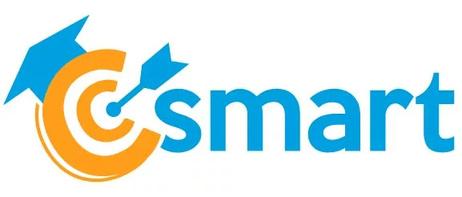

"My community college is a place where nontraditional students can find their calling, even at a late age.”

interest while earning the degree necessary to improve my children’s lives
That decision helped me achieve academic excellence despite feeling like the odds are constantly stacked against me Athens Technical College offered me the opportunity to return to school to fulfill a lifelong dream in an environment that makes me comfortable, with instructors who care about my success, and at a cost th at even a lowincome single mother of three can afford My community college provides me with the skills to become the person I am today and the GREAT nurse I will be!
BENEFITS OF ATHENS TECHNICAL COLLEGE
*Affordability: The tuition and fees are a fraction of the cost for a university At $100 per credit hour
*Flexibility: Courses are available during the day and evening in a variety of formats including in-person, hybrid, web-enhanced, and fully online
*Hands-on Learning: All programs have a combination of classroom and real-world applications, offering you the chance to practice and perfect your chosen career path Plus, our labs and equipment are aligned with education and industry standards if not exceeding them

*Transferability: Want to keep pursuing further education? Many of our students go on to public and private colleges and universities for advanced degrees There are 28 courses that transfer directly to the University System of Georgia institutions www.athenstech.edu



1
and administrators. The chapter also collaborated with the vice president for student affairs and the director of public relations to ensure college permissions and social media outreach efforts.
During biweekly committee meetings from August to November 2024, the team discussed upcoming recruitment events, ways to improve presentations, quantitative and qualitative outcomes from previous events, and travel arrangements. Communication with the steering committee was efficient and well-organized. However, coordinating with over ten important administrators presented unique scheduling challenges. To address this issue and ensure the project progressed smoothly, we requested suitable replacements for any members who were unable to attend a meeting. This approach helped us stay on track with our commitments.
Addressing team concerns and to keep everyone apprised of progress, the chapter president updated the steering committee and PTK team leaders weekly to inform them about upcoming CCsmart recruitment events, and the executive officer maintained a shared calendar of events. Lastly, team leaders compiled a
Student Aid, SkillsUSA, and Jack Kent Cooke Foundation.
Impact
The PTK College Project team successfully developed information packets along with project resources for our CCsmart initiative. They participated in three college fairs organized by the recruitment coordinator and delivered CCsmart speeches to first- and secondyear classes. Other activities included collaborating with student ambassadors to conduct multiple college tours, participating in a biannual college expo that featured both internal and external organizations, attending three speaking engagements at a local high school, and taking part in one high school career fair. Through these events, the team reached over 1,500 prospective and current students.
Creating both an in-person and an online survey to collect student feedback on the CCsmart talks, key results showed that 100% of respondents reported learning something new from the presentations. Among those planning to attend college, 62% expressed interest in considering a community college, while 74% of those not planning to attend college said they would also consider it. Additionally,
Donna Kent, Athens Technical College - Athens, Georga
Figure



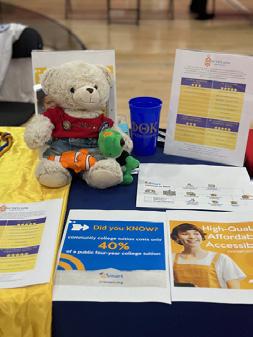
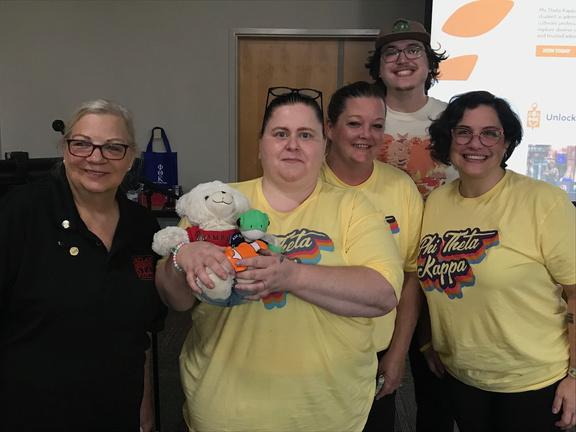
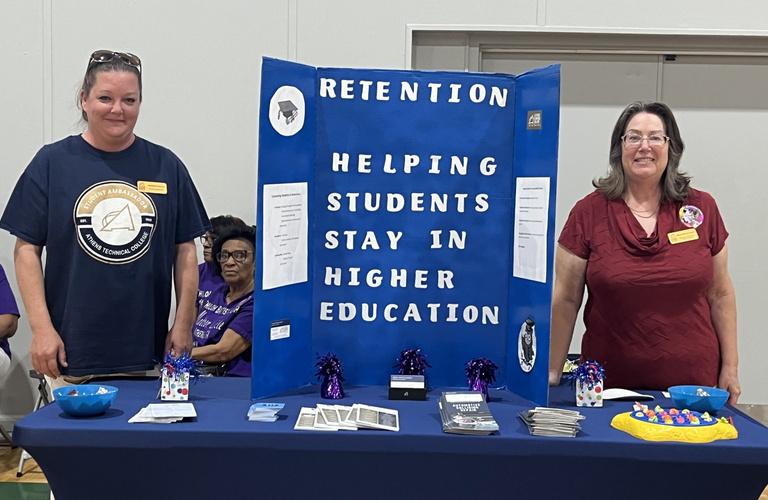
Recognizing Excellence in Academics and Service with Alpha Tau Zeta
RECOGNIZING EXCELLENCE IN ACADEMICS AND SERVICE


Chapter–College Relationship

100% of currently enrolled respondents stated that they intend to complete their degrees (Figure 3). Reflecting after a college fair, one parent said she was happy that her son could hear personal narratives about college experiences from current students. All attendees appreciated engaging with our team.
Through this experience, the College Project team enhanced their professional skills and gained a better understanding of the CCsmart initiative. They learned effective strategies for collaborating within a diverse group and emphasized the importance of teamwork. Team members developed as servant-leaders and remained dedicated to completing their degrees. The College Project was a collaborative experience, with each member contributing unique skills that fostered creativity and engagement. It was a successful endeavor that promoted the team’s lifelong learning and service.
Maintaining a positive and respectful relationship between PTK and the college administration is a top priority for our chapter. Because of our chapter’s dedication to servant leadership, the college administration often expresses their satisfaction with the chapter’s positive impact on the college and the community.
Our relationship with the college provided many benefits to the 2024 College Project: the dean of general education provided access to classes for presentations, the recruitment and retention coordinators provided a list of college and career fairs, the vice president for student affairs provided access to the guided tours, and the director of student activities provided a space for PTK to set up at the biannual expo. This project strengthened relationships and forged new connections in college areas like recruitment and retention, paving the way for additional PTK engagement.
The results of this College Project significantly strengthened the relationships between the college and PTK. This was demonstrated by the recruitment coordinator’s follow-up with advisors when she expressed her gratitude for the project team. The coordinator was particularly impressed by the chapter president’s ability to speak comfortably to prospective students, generating positive and engaging responses. The coordinator encouraged the team to continue their involvement by attending future recruitment and retention events.
Benefiting from our monthly college–chapter teambuilding meetings, the team reviewed the CCsmart campaign project results at an end-of-the-year holiday brunch.
Figure 2
Figure 3
Creating a User-Friendly Institutional Research Board
Proposal
Alpha Alpha Sigma Chapter Howard College Columbia, Maryland
Abstract
In early spring 2024, the leadership team reviewed the college’s mission statement, “Providing pathways to success,” and requested meetings with the senior team of the Planning, Research, and Organizational Development (PROD) department and the leadership team of the Honors and Undergraduate Research (HNUR) department to determine a College Project that aligns with the college’s mission and PROD’s goals.
The College Project undertaken by the Alpha Alpha Sigma Chapter aimed to clarify the process of submitting an Institutional Review Board (IRB) proposal package at Howard Community College. This process is essential for anyone conducting research involving human subjects, as it ensures adherence to ethical research practices. In alignment with our college’s mission, our leadership team developed an accessible and comprehensive guide for students and faculty to understand the process of submitting an IRB proposal package.
Beginning in late spring 2024, after several meetings, we officially partnered with the PROD department— which evaluates all submitted IRB proposals—to deepen our understanding of the process. As a result of these discussions, we created a pilot Canvas module within three Honors Program Canvas courses. The module features a step-by-step guide for submitting an IRB application, including guidelines, templates, and examples. To assess the module’s effectiveness in helping students understand ethical research practices, we included pre- and postsurveys.
Planning
The idea for creating a more accessible IRB proposal process originated from last year’s College Project. That project focused on gathering the necessary information and documents to submit a complete and effective IRB proposal.
“This process is essential for anyone conducting research involving human subjects, as it ensures adherence to ethical research practices.”
related to IRBs and the protection of human subjects in research.
Team members also developed communication and organizational skills through leading chapter meetings and participating in library work sessions. These sessions focused on researching scholarly articles related to our topic and improving our writing through annotated source work.
Collaboration
After completing the previous project, our leadership team met in person with Dr. Cheryl Campo, head of the HNUR department, to gather feedback. We realized that preparing and understanding the IRB process was overwhelming. In response, we worked with Assistant Director of HNUR and PTK advisor Ms. Bethany Pautrat and the PROD department through virtual meetings and emails to find a way to make the information more understandable and accessible to students and faculty at HCC.
Through these discussions, our team and PROD agreed to create a more streamlined and accessible process for developing an IRB proposal. We decided to build a Canvas module that includes templates, sample documents, and clear steps for submitting a proposal.
Building on this idea, we held multiple leadership meetings throughout spring and summer 2024 to assign roles for creating each page of the module. Our team also completed the Protecting Human Research Participants (PHRP) training course to better understand the IRB process, with costs covered by HNUR.
From Spring through early fall 2024, the leadership team met with PROD to present updates to the module, incorporate their feedback, and make the necessary changes for final approval to upload to Canvas.
Leadership Development
As part of the IRB application process, all members of the PTK leadership team were required to complete the PHRP training. This provided essential knowledge about federal regulations and ethical principles
Communication with collaborators occurred through Zoom sessions, in-person meetings, emails, and group texts. After our initial Spring 2024 meeting with PROD, the leadership team met weekly or biweekly to write, plan, and discuss progress. We also organized several work sessions with PTK members in late Spring to gather feedback and additional insights.
Throughout spring and summer 2024, we held biweekly Zoom and in-person meetings, along with weekly group text check-ins with Ms. Bethany Pautrat and Dr. Campo. Their feedback helped us stay focused on the project’s goals and navigate challenges.
We kept PROD updated on progress and any obstacles through email and Zoom meetings to ensure our work stayed aligned with IRB policies and PROD’s expectations.
For example, the original plan involved creating a separate Canvas course focused on the IRB process. However, due to requirements from the Center for Learning Excellence, we have not yet secured approval for a standalone Canvas. As a result, we are conducting a pilot test of the module in fall 2024 using the PTK and HNUR Canvas shells, with ongoing discussions about creating a dedicated course in the future.
Impact
Initial pilot test data indicates we are successfully achieving our goal: creating an accessible, comprehensive guide to the IRB process for students. Pre- and post-survey results showed that all participating students (2 of 2) felt more confident in assembling an IRB proposal after using the module. They also agreed that the module included all the necessary materials and that the templates were easy to use.
At HCC’s Innovation Fair, where we presented the pilot module, several students and staff shared they didn’t know the college had an IRB and appreciated our efforts to raise awareness. Others who had completed IRB applications in the past said the module presented the process in a more userfriendly way.
The surveys also included open-ended feedback. One participant noted that “teaching about the IRB through a Canvas module [was] really accessible and easy to use.”
Overall, the project had a strong impact on team members. We grew as scholars and leaders by taking ownership of specific tasks. This included learning HTML and organizing content into a user-friendly Canvas module, applying advanced research and writing skills for the IRB methods section, and developing professional communication and time management skills through regular meetings with campus leaders and faculty.
Chapter–College Relationship
Through consistent communication with PROD, our chapter built and strengthened a strong working relationship with their office. The leadership team developed a clear understanding of the roles each staff member played throughout the project. Early on, we worked with Christie Ewing, now director of research and planning, as our main contact. As the project advanced, we were introduced to Dr. Rhou, research associate, who provided feedback on our work. In the final stages, we connected with Dr. Shantay Grays, provost and executive vice president, and Candace DePass, associate vice president of learning engagement, for final approval of the project’s implementation.
We also deepened our chapter’s commitment to student research by presenting our work at the Innovation Fair in May. During the event, we engaged with several members of the PROD office, including the director at that time, who expressed enthusiasm about our presentation and the final product. These interactions helped increase visibility for PTK on campus and demonstrated our shared commitment to academic excellence and student support.
Project Student-Parent Awareness
Alpha Zeta Omicron Chapter
Dallas College Cedar Valley Lancaster, Texas
Abstract
Alpha Zeta Omicron (AZO) studied Dallas College’s mission statement: “To transform lives and communities through higher education by: Ensuring Dallas County is vibrant, growing, and economically viable for current and future generations, and providing a teaching and learning environment exceeding learner expectations while meeting community and employers’ needs.” The chapter gained insight into the institution’s current priorities by teaming up with the Cedar Valley campus president, Dallas College board members, and faculty across Dallas College campuses. Student parents were repeatedly highlighted as needing additional support to reach their educational goals. Dallas College began taking steps in 2023 to remove barriers and implement programs that align the student-parent experience with the institution’s vision.
Once our institution expressed the need for support in advancing these student-parent initiatives, we established shared objectives and began collaborating with on-campus and community partners to complete the College Project (CP): Project Student-Parent Awareness (SPA).
The chapter implemented Project SPA to raise awareness of college and community resources available to Dallas College students and families while focusing on new initiatives. The project was inclusive of current and prospective student parents, aiming to destigmatize the studentparent academic journey.
Planning
The planning process for Project SPA began by researching Dallas College’s upcoming priorities,
followed by virtual and in-person meetings. The planning process incorporated six steps and three phases. The six steps included:
• Meet with the campus president and review the college mission/priorities.
• Analyze CPs completed in the past five years.
• Jointly decide on focus, goals, and collaborators.
• Create and implement a work plan by developing SMART (Specific, Measurable, Achievable, Relevant, and Timely) goals while remaining flexible.
• Formulate a communication strategy for the chapter and stakeholders.
• Track the quantitative and qualitative outcomes of Project SPA and present a final report to all collaborators.
After exploration, AZO learned that Dallas College is participating in a two-year cohort (2023–2025) with the nonprofit Generation Hope. During this cohort, Dallas College committed to making permanent changes to benefit the student-parent population. AZO held several chapter meetings, brainstorming ways we could assist in this high-need area. Eventually, our chapter met with the campus president (Figure 1) and administration to share our findings; it was confirmed that Dallas College needed assistance in completing several initiatives for student parents. Given this information, the CP was mutually determined by the campus president and AZO. Administration then appointed our chapter to collaborate with Generation Hope and complete specific tasks as part of the CP.
With the topic selected, we developed SMART goals, a list of collaborators, and a shared calendar to ensure deadlines were met. The communication strategy prioritized informal communication among members and officers via text, allowing us to share creative ideas quickly.
We tracked our impact by reviewing the number of students reached through hosted events and engagements. To analyze the quality of our project, we surveyed our demographic, reviewed rubric feedback from the school board, and peerinterviewed each other regarding our College Project experience.
Leadership Development
Before embarking on this journey, team members decided it was necessary to gain a deeper understanding of institutional hierarchy and


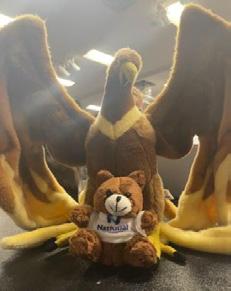
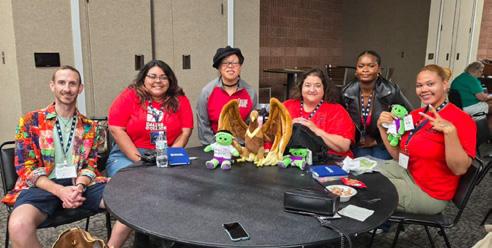


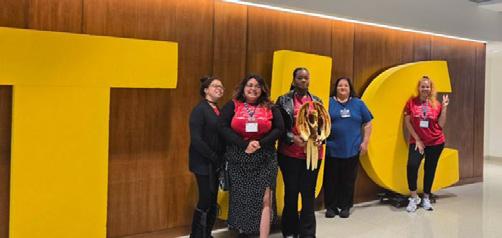
the policies our institution must follow. This knowledge allowed us to identify what changes we were capable of making. AZO met with campus administration to learn about faculty/staff roles, how they could offer assistance, and how to contact them. The chapter attended Change Management Convening, a workshop hosted by Generation Hope, which provided information on roles in higher education (Figure 2). Additionally, facts and statistics were presented to explain how the intersectionality of race, poverty, and student-parent status is common. This information was essential to understanding the student-parent demographic on our campus.
While attending the workshop, we were introduced to the admissions dean at Johns Hopkins University. The dean invited us to attend a virtual seminar on the resources and technology their campus provides to student parents, which inspired our chapter to research, advocate for, and implement new resources.
The chapter also attended the PTK Texas Leadership Conference (Figure 1), where we strategically spread members across workshops and later debriefed as a team. This helped us recognize the value of diverse strengths and made it easier to delegate tasks accordingly. We also strengthened our ability to use social media for advocacy and influence.
Figure 1
Figure 1




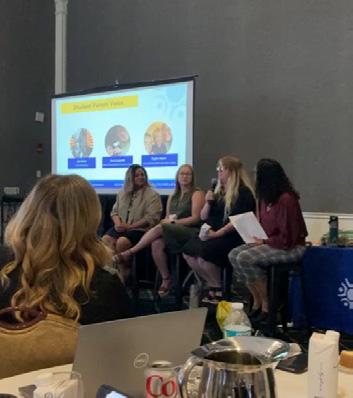


As advocates for the student-parent experience, we spoke with many Dallas College families. These conversations revealed common barriers, such as lack of childcare, insufficient resources, limited family support, and stigma from faculty and administrators. We also surveyed our sample pool about existing student-parent resources on campus.
This knowledge allowed us to leverage communityprovided services, human capital, and our newly established relationships with college faculty to implement Project SPA.
Collaboration
We carried out Project SPA by facilitating awareness events on campus and at local high schools, hosting a panel, organizing a book drive (Figure 2), and using social media representation.
Completing these tasks required consistent and efficient communication within AZO and with our collaborators. Discord™ and Microsoft Teams™ channels supported continuous chapter communication. Project SPA updates were shared with the campus president in person, as well as electronically and by phone with all collaborators. We held in-person meetings and gatherings on campus
and offered virtual options, understanding that many student parents work full time.
Despite our efforts, one of our biggest challenges was a lack of communication and follow-through from stakeholders, especially regarding the “Little Libraries” (designated areas for students and their children to borrow or donate books). Although Dallas College was working hard to address numerous student-parent needs, the Learning Commons dean and collaborators could not prioritize this initiative due to time constraints.
We overcame this obstacle by adjusting our approach. Our chapter advisors assisted with structuring and coordinating a book drive. We collected craft material donations, and our chapter secretary/treasurer created original coloring pages for children on campus (Figure 3). These actions met the need for early literacy resources that the Little Libraries would have fulfilled.
Impact
• Increased visual representation of Dallas College families on campus
• Surveyed 500+ current and prospective student parents in person/virtually; received data from 110+ participants
• Updated the Dallas College website with the marketing assistant director and social media assistant director
• Added a landing page for the Family Care Program
• Gathered photos of student families/family spaces for the Dallas College website
• Submitted images of Dallas College families to Seeing Yourself, a presentation hosted by a program coach and the Generation Hope CEO
• Promoted family care resources available to current and prospective students
• Moderated a 60-person student-parent panel
• Distributed materials to 19 teen parents at Lancaster High School
• Hosted an informational session during the Week of Workshops
• Presented “Student-Parent Advocacy” PowerPoint™ during the president’s What’s Happening Cedar Valley campus-wide meeting
• Facilitated enrollment session for Dallas Promise, a program for parents of local high school students to receive no-cost education at Dallas College
• Collaborated with the Student Care Network and Family Care Program across Dallas College campuses
Figure 2
• Led a book drive (71 books) (Figure 2)
• Attended Generation Hope Change Management Convening workshops in Rhode Island and Washington, DC
• Participated in Generation Hope presentation/ advocacy training
• Attended ribbon cutting for the Child Watch Program
• Presented a Student Success workshop
• Collaborated with the Student Care Network dean
• Supplied craft materials to campus family areas (Figure 3)
• Partnered with Dallas County and Dallas College organizations on and off campus
• Connected with the Dallas Public Library
• Shared Project SPA with the Dallas College Board of Trustees
• Toured Bezos Academy, the on-campus Montessori-inspired preschool
• Established a relationship between Dallas College and Dallas County’s Early Childhood Intervention (ECI) Center
• Met with the Learning Commons dean
• Increased AZO chapter awareness
• Toured four campuses with the student-parent liaison
• Promoted AZO at the PTK Expo
• Recruited a public relations officer for AZO
• Published frequent social media updates and photos
• Branded donations with the AZO chapter logo
Alpha Zeta Omicron was deeply moved by completing Project SPA. One of our co-presidents, a student parent, shared, “I felt understood and included by talking about the additional challenges I face in my college career. I am now aware of resources available on campus.” Overall, we harnessed the power of inclusivity and helped create a stronger, more connected campus community.
Chapter–College Relationship
This project allowed Alpha Zeta Omicron to connect more deeply with Dallas College administrators, faculty, and staff. Unbeknownst to our chapter, over 69% of instructors on campus had once been student parents. Whether in graduate school or during their undergraduate years, many instructors supported our efforts because they understood and empathized with this population.
Because Dallas College had already committed to student-parent initiatives but needed help reaching the demographic, we worked closely with

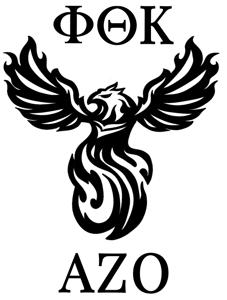


the Student Care Network dean and the campus president to complete a specific work plan in partnership with Generation Hope. This collaboration provided a clear direction for Project SPA and inspired AZO to grow as servant leaders, leaving a positive impact on the college and community.
During our chapter promotion efforts, we also built new relationships with the e-learning quality associate dean and the marketing assistant director. These connections will make it easier for AZO to use Dallas College’s digital marketing tools to promote both Project SPA and the chapter.
Figure 3
Figure 3
The “Commit-to-Complete” Initiative: A Dual-Purpose Approach to Fostering Retention and Honoring Student Perseverance
Upsilon Gamma Chapter
Middlesex College
Edison, New Jersey
Abstract
Middlesex College is a richly diverse institution that equips all students with the skills, resources, and support they need to “explore, grow, and thrive.” Guided by its focus on student-centered, mutual learning—measuring its success by that of its students—the administration invited the Upsilon Gamma Chapter to collaborate on an initiative to improve retention and graduation rates while recognizing student efforts. Embodying Phi Theta Kappa’s core values of academic excellence, leadership, and community engagement, this initiative aims to empower students to succeed during their community college education and beyond.
President Mark McCormick presented our chapter with the challenge of creating and promoting an initiative to improve student retention and graduation rates. Working with Vice Presidents Laureano and Scherr, we developed the “Commit-to-Complete” initiative, a dual-purpose program aimed at enhancing student retention and recognition. The team launched the initiative at New Student Day and the Student Engagement Fair (Figure 1), where students made personal commitments to completing their education by signing pledges and adding their names to a banner displayed in the College Center. With the support of our IT department, we implemented a card-swipe system to track participant progress and recognize their achievements at graduation. Through this comprehensive approach, we engaged over 600 students, creating a culture of commitment and celebration of academic persistence.
Planning
Following President McCormick’s initial request, the chapter conducted a thorough review of the college’s strategic priorities and institutional needs for the 2024–2025 period. Through extensive discussions with Jose Laureano, vice president of student and enrollment services, and Linda Scherr, vice president of academic affairs—experts in the academic success of the student body—we identified successful elements from previous retention initiatives while discovering opportunities for enhancement. These collaborative meetings revealed the potential to revitalize an earlier retention program by aligning it with Phi Theta Kappa’s values and the College Project framework.
Our executive board, comprising the chapter president and seven departmentalized vice presidents, synthesized feedback from diverse chapter members to ensure the project addressed comprehensive student needs. Key improvements included integrating data-driven tracking systems and adding a recognition component to inspire perseverance and honor student contributions. The finalized proposal garnered enthusiastic support from members, leading to swift volunteer recruitment and targeted training programs to bring the initiative to life.
In summary, the planning phase involved:
1. Reviewing the goals of PTK’s College Project initiative and the college president’s retention objectives
2. Identifying and engaging in collaborative discussions with key administrative stakeholders, Laureano and Scherr
3. Strategizing to integrate recognition for graduates as a supplementary element
4. Coordinating logistics, including tabling events, promotional materials, volunteers, and data management
Leadership Development
Chapter President Samantha Ayers and Vice President of Leadership Richa Sharma utilized insights from a chapter-wide skills assessment to design targeted training workshops (Figure 2) aimed at developing essential skills, including event planning, communication, leadership, and data tracking. Recognizing the need for enhanced leadership preparation, the chapter also launched a summer campaign to promote PTK Edge enrollment.
Member feedback highlighted PTK’s Leadership Development Studies course as a pivotal resource in


shaping volunteer strategies; participants specifically noted how techniques in voice projection, eye contact, and professional presentation dramatically improved their ability to communicate project goals and benefits to potential participants. Similarly, Research Edge equipped members with crucial skills in academic investigation, source evaluation, and effective writing techniques, empowering them to understand and communicate the psychological research supporting the connection between formal commitments and program completion—the theoretical foundation of our project.
As the implementation phase neared, Service Vice President Dhruv Sethi delegated specific responsibilities to volunteers to efficiently execute all project components:
Figure 1
Figure 2

1. Capturing the attention and interest of attendees
2. Communicating the project’s goals and benefits of participation
3. Assisting students with completing information forms
4. Encouraging banner signatures
5. Managing the digital card swipe component
6. Regularly updating team and administrative leadership on progress and feedback
Collaboration
After its goals were conceived, stakeholders informed, the chapter trained, and logistics devised, the Middlesex College Commit-toComplete initiative was set for implementation. In the weeks leading up to the campus’s New Student Orientation and Involvement Day, chapter leadership maintained consistent communication with volunteers, college administration, and the student life and IT departments through email, Zoom meetings, and in-person discussions to maximize outreach and ensure a seamless project launch. To secure placement at the event, the executive board proactively contacted the student life department to request a registration form, which the service vice president completed. The service vice president then shared their details with the recruited volunteers. We informed the college administration of our attendance and regularly visited our table to monitor student progress,
gather feedback, and assess interest in our project’s pledges (Figure 3).
Held on August 23, the event saw nearly 500 students, representing diverse demographics, pledge to complete their programs. The campus IT department supported the initiative by implementing ID card-swipe technology, enabling accountability and long-term tracking. While the chapter initially faced challenges with this resource, we successfully integrated it into subsequent events. For New Student Day, the team adapted by using paper records to capture students’ college emails, ID numbers, pledges, and names. This allowed for manual entry into the progress-tracking software after the event, ensuring recognition of their commitments. Based on participant feedback, paper pledges remained a feature at future events, complemented by the ID-swipe system to streamline the process.
Following the launch of New Student Day, chapter members maintained open communication with college administrators and collaborators, providing regular updates to stakeholders to ensure transparency, alignment with the college’s objectives, and adaptability in their approach.
Impact
In early September, the administration invited the chapter to participate in the Student Engagement Fair, further extending the reach of our project. This opportunity allowed us to engage not only with first-year students, but with returning and transfer students from varied socioeconomic backgrounds. Across both events, we engaged students from a wide range of academic disciplines and traditionally underrepresented groups, such as adult learners, racial minorities, and transgender students. By encouraging involvement from all attendees, we highlighted the essential role of community colleges in empowering students with diverse life experiences through opportunities and support, enabling them to achieve their goals.
Having supported over 600 students in their educational commitments—marking a tenfold increase in engagement compared to previous student outreach events—the project shifted toward its assessment phase as the semester progressed, providing time to reflect on our efforts, approaches, and outreach during our monthly executive board and membership meetings. At the heart of our project’s legacy was its impact on the students it was designed to serve:
Figure 3
several participants expressed gratitude for the initiative, noting that the promise of recognition at graduation served as a source of motivation during challenging moments in their academic paths. This feedback reinforced the importance of tying retention efforts to the acknowledgment of individual accomplishments, making the Committo-Complete initiative a defining element of the college’s support framework.
By addressing President McCormick’s request and collaborating with Vice Presidents Laureano and Scherr, the chapter demonstrated its commitment to both institutional retention priorities and Phi Theta Kappa’s student-centered approach to academic growth. In doing so, members demonstrated remarkable growth in professional skills, particularly in data analysis, project management, and stakeholder communication.
Chapter–College Relationship
Recognition has proven highly effective in promoting student retention: publicly celebrating graduates who fulfilled their pledges has bolstered perseverance and dedication, reinforcing the project’s core values. The chapter envisions this form of recognition becoming a cornerstone of the college’s graduation culture. By inspiring students and showcasing the diversity of successful graduates, this initiative can continue to strengthen retention efforts while honoring the unique journeys of our student body. The college administration repeatedly praised the program, showcasing it on LinkedIn to inspire similar efforts across the community college landscape. As commented by President McCormick, “I am proud of the work our amazing Middlesex College Phi Theta Kappa students are engaged in with the Commit-to-Complete campaign.”
With the fall semester complete, we look forward to evaluating early graduation outcomes and supporting continued student progress in the spring. Our efforts will culminate in a comprehensive report on student progress, examining criteria such as background and major to help the administration refine its approach to student needs. This report will combine raw data, including participant engagement at tabling events, with software insights from the technology department on degree progress, enabling us to assess the initiative’s long-term impact. Together, these components will provide data-driven insights into retention and graduation trends,
which can be shared with stakeholders, including the administration, to guide future improvements.
Moreover, the initiative fostered trust and collaboration between the Upsilon Gamma Chapter and the administration, reinforcing and expanding the chapter’s leadership role in supporting student success, as evidenced by the administration’s decision to showcase our work and integrate our recognition component into future graduation ceremonies.
Note: In the months following the success of the chapter’s initiative, Middlesex College garnered significant attention with a groundbreaking dualadmissions agreement with Rutgers University. Guided by President McCormick’s vision for student success and supported by our Commit-toComplete collaboration, this partnership provides a seamless pathway for students to advance their education after graduating. Through the program, students who earn their associate degree at Middlesex College can transition to Rutgers as third-year students, enjoying benefits such as a waived application fee and guaranteed credit transfer. This groundbreaking opportunity exemplifies how collective efforts and visionary leadership can open doors for continued academic and personal growth. As we celebrate the successes of our initiative, we remain committed to empowering students and building a legacy of support that will shape the future of Middlesex College and benefit its past, present, and future students for years to come.
Promoting Career and College Promise Dual Enrollment
Alpha Xi Tau Chapter Surry Commmunity College
Dobson, North Carolina
Abstract
Alpha Xi Tau, in partnership with Surry Community College (SCC), created a series of videos for the college’s website. They feature chapter officers answering common questions asked by Career and College Promise (CCP) students and their parents. CCP offers students the opportunity to earn college credits while still in high school. They can earn an associate degree, and their parents do not have to pay for tuition or textbooks. Administration has focused on this group for several years because they represent an ever-increasing percentage of our student population.
Because of them, the college has maintained its enrollment numbers even when the percentage of traditional students dropped. The more students are enrolled, the more funding the college receives from the state; therefore, attracting new CCP students has become a current priority and an innovative way to accomplish this goal.
However, before enrolling, these potential students and their parents ask many questions. Providing answers through a student-to-student perspective gave our chapter an opportunity to support the college’s current priority and allowed us to help fulfill its mission to “promote personal growth and community development to a diverse population through excellence in teaching, learning, and service.” We could attract new CCP students by teaching local families about this great opportunity. The college could keep its enrollment numbers stable, and parents could save time and money putting their teenagers through college.
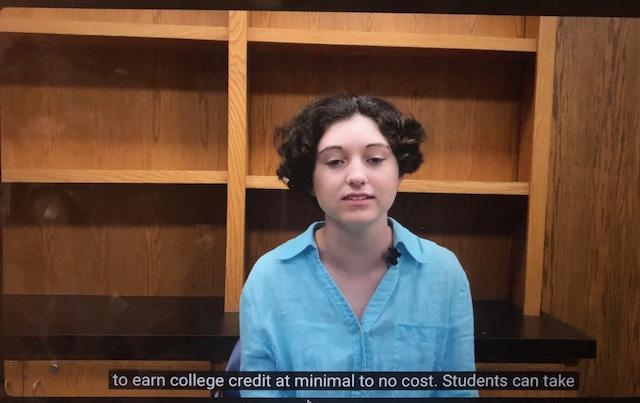

Planning
In January, we read the school’s mission statement and brainstormed a list of possible projects. We then scheduled a meeting with the college president and his cabinet. After listening to our ideas, they proposed we create a set of informational videos for our CCP students and their parents (Figures 1 and 2). Because such videos would support both the college’s mission statement and its current priorities, we agreed to work on the project. To accomplish this goal, we needed a team and a timetable.
Asking for chapter volunteers, we then chose our collaborators: the senior vice president to oversee our project; web designers (WD) to construct a webpage to house it; student services (SS) to provide information and video topics; the marketing director (MD) to provide format and film guidance; and the training director (TD) to caption our videos.
Our team selected seven questions frequently asked by potential CCP students and their parents; then we set deadlines for each stage of the project. We also scheduled frequent communication between our team and administration. Teamwork and communication were critical to accomplish our mutual goal.
Leadership Development
To implement our part of the project successfully, we needed three very specialized skills: scriptwriting, acting, and videography. We knew to keep the scripts short with very clear and
correct content. However, we did not know what that content was or how to write it effectively. Therefore, we sought experts for advice and training.
We first asked SS to provide answers for each of the questions. Then, we contacted English instructors for advice on organizing and writing the information. They taught us about audience awareness, focus, and concision. They also showed us the power of revision.
To strengthen our acting skills, we turned to our chapter president. As a social influencer, she has a YouTube channel on which she posts product reviews. Therefore, she was able to give us basic advice on looking good for the camera, maintaining eye contact, effective public speaking through video, and using good posture and body language. We asked the MD for pointers on projection, enunciation, and speed. To improve our videography skills, the MD also taught us about format, camera, locations, lighting, sound, and cue cards.
Collaboration
After learning these necessary skills, we were ready for the next stage of our project: writing scripts. Aimed at high school students and their parents, each of these focused on one question, answering it clearly and concisely. We sent the rough drafts to SS to double-check our facts. Once they were satisfied, we then sent them to the MD, who requested several changes. Only after she approved our revisions did we send them to the senior vice president for final
Figure 1
Figure 2
approval. When we received the thumbs-up, we were ready to start filming.
Dividing the seven scripts among ourselves, we filmed the videos on our personal phones. However, we ran into difficulty. Some of our phones were Apple and some were Android, which made sharing videos difficult. We tried casting them to a laptop, which sometimes worked and sometimes did not. So, we then tried using an Ethernet cable to connect the devices. They still would not communicate. Frustrated, we asked technology services for help. They suggested we upload the videos to OneDrive. This sounded easy but ended up being impossible because of the file size. Even though they were only 30–45 seconds long, they were still too big for our student OneDrive accounts. Technology services had to upload them for us.
However, that was not the end of our challenges. Some of the videos uploaded with only sound and no images. Others recorded vertically rather than horizontally as marketing had requested. We tried re-filming; however, the problem persisted because some phones, even when held horizontally, still recorded vertical images. At this point, we realized it was not a good idea to use our personal phones. That’s when the MD allowed us to use the college’s AV equipment.
We dressed in business casual for the recording session and printed the scripts on 11x17 cue cards. The MD loaned us a college phone on a tripod, which she connected to a wireless lapel microphone. We then re-recorded all of the videos in a single session with the MD in attendance. That ensured a consistent quality and format. We then had no problem uploading them to OneDrive.
Next, we sent the videos and scripts to the TD for captioning in both English and Spanish. She also added the college logo before returning the videos to us for proofreading. While fixing the English version was easy, we had to ask a Spanish instructor for help proofreading the Spanish version. She made a few suggestions, which we passed to the TD. The resulting corrections were sent back to us and to the MD.
At this point, we thought we were almost done; however, the MD found a mispronunciation in two of the videos. We feared we would have to refilm them yet again. With relief, we learned the TD only needed a voice recording to insert over the mistake. After a little practice, we made the recording and sent it for editing.
After the senior vice president received the final videos in April, she called a team meeting reviewing our progress. Although pleased with our work, she recommended changing from open to closed captioning to be more ADA-compliant. Once the TD made these changes, the senior vice president took the videos to the vice president of instruction and the vice president of student services for their approval. They requested only one revision. Contacting the MD, we arranged another recording session and sent the revised video to the TD for editing.
Meanwhile, the WD made a new webpage devoted to CCP. Our videos are housed there: https://surry.edu/areas-of-study/high-school/careerand-college-promise
Once the webpage went live, we sent the link to all team members, congratulating them on the successful completion of the project and thanking them for their collaboration.
Impact
According to the NC Community College System’s data dashboards, in fall 2023, SCC had 1,309 dualenrolled students, comprising 44% of our total enrollment. In spring 2024, we had 1,251, which was 46%. Our director of student success and academic advising expects this to rise to 50% by fall 2024 because of college efforts to attract new students. Our videos are part of that effort. The MD estimates a 10% increase in views of SCC’s new CCP webpage.
Increased views raise increased questions, so our videos are centrally located on the webpage, directly above the list of available CCP programs, where they can answer many of those questions and draw more potential students.
Our project made a substantive impact, helping the college fulfill its mission by raising interest in the CCP program. In addition, it helped us. Not only did we learn useful skills in script writing, acting, and videography, but we also learned to work with a diverse range of people. The challenges we faced reinforced the value of flexibility and patience. We are PTK, and we can do anything and overcome any obstacles while striving for excellence.
Chapter–College Relationship
By working smoothly and efficiently with college personnel, we earned a good reputation. Before
this project, the college already celebrated the academic achievements of our members, and it recognized us as role models for other students. Now, college administration also sees us as valuable allies. Through our work, we are helping to draw potential students to our college’s CCP program—not just this semester, but for many years to come. Increasing their enrollment directly results in increasing state funding, and it helps keep our college alive even when so many other community colleges are struggling.
However, this project also benefited us. Through it, we grew in professionalism and as servant leaders. Not only did we work well in collaboration with college employees from many different fields and backgrounds, but we also learned valuable skills in the process: organization, time management, and follow-through, to name just a few. Plus, by effectively leading this project, we served the greater good for both the college and the students. Drawing students to higher education opens to them a range of possibilities, increasing not only their job opportunities but also their earning potential, which is not only good for them but also good for the whole community.
Health and Wealth: Preparing Students for a Balanced Future
Rho Kappa Chapter
Elgin Community College
Elgin, Illinois
Abstract
Our College Project, Health and Wealth: Preparing Students for a Balanced Future, is designed to empower Elgin Community College (ECC) students by focusing on both their physical and financial well-being. Many students face financial hardships that impact their access to nutritious food, which, in turn, can affect their academic success. Our project aims to provide essential tools to help students manage their finances and maintain their health, setting them up for long-term success.
One of the central aspects of our project is the enhancement of the campus pantry. By expanding its offerings, we aim to ensure students have access to nutritious food. Hunger is a real barrier to student success, and by offering healthier options, we help reduce hunger so students can focus on their studies without the worry of where their next meal will come from. In addition, our financial literacy workshops equip students with budgeting skills to make the most of their resources, starting with the pantry’s offerings.
Physical wellness is another core part of our project. We incorporate yoga sessions and nutrition workshops to promote healthier living. Yoga provides both physical and mental benefits, and we ensure that all students have access to these benefits by providing mats. The nutrition workshops emphasize that healthy eating doesn’t have to be expensive, offering quick and affordable recipes using pantry ingredients.
Our collaboration with KCT Credit Union was integral to the success of the project. Together,
we created an 11-member Student Advisory Board to ensure our initiatives meet the needs of the students and to promote financial education. One exciting initiative was the Game of Life activity, where students practiced real-life scenarios like budgeting, paying bills, and managing emergencies. This hands-on experience allowed them to develop critical decision-making skills in a safe, supportive environment.
Our project focuses on four key goals:
1. Enhancing Financial Literacy – focusing on credit score, credit report, budgeting, and fraud recognition.
2. Promoting Physical Wellness – through yoga and nutrition education.
3. Supporting Student Resources – by expanding the pantry’s offerings.
4. Fostering Community Engagement – by gathering student feedback and hosting events.
By aligning with ECC’s mission to support student success, our project addresses students’ physical, financial, and emotional challenges, empowering them to thrive both on and off campus.
Planning
The planning process for our College Project began with brainstorming sessions with our Phi Theta Kappa (PTK) advisors, Amybeth Maurer and Ali Kashani, and our officer team. These sessions focused on key themes of financial literacy and physical wellness, which were essential to the success of the project. We worked together to develop a comprehensive project plan and proposal, outlining clear goals, a timeline, and strategies for our workshops and the enhancement of the campus pantry. ECC President Dr. Peggy Heinrich also played an important role in these brainstorming sessions, helping refine the project’s direction. We were able to leverage the strengths of several partners to help bring our project to life.
• Financial Literacy: KCT Credit Union provided budget planners and financial expertise through a campus booth, open 3-4 hours a day, twice a week. They also established a Student Advisory Board, offering students opportunities for personal and professional growth.
• Physical Wellness: In collaboration with Mr. Corsair Mack from the Wellness Center, we connected with Dr. Jennifer Maxwell and Ms.
Andrea Hinojosa (a registered dietitian) who contributed their knowledge to our wellness workshops.
• School Pantry Enhancement: We worked with Biology and Nutrition professors to expand the pantry’s offerings with healthier and more affordable options.
• Campus Support: Richard Essegian, director of the cafeteria, provided snacks for workshops, while TRIO, the library committee, biology professors, and student government helped spread awareness and gather student feedback through surveys.
Weekly meetings ensured the project stayed on track, with specific responsibilities assigned to each officer. One unexpected but wonderful opportunity arose when ECC President Dr. Heinrich volunteered to lead a yoga session, adding a personal, motivational touch to our wellness activities.
Leadership Development
To successfully implement this project, we needed a variety of skills, including organization, communication, teamwork, flexibility, and adaptability. Though we didn’t have formal training, we strengthened these skills as we worked through each stage of the project.
• Organizational Skills: With multiple workshops to promote and student attendance to track, staying organized was crucial. Each officer had specific tasks, from promotion to ensuring communication between all team members. Weekly check-ins and updates kept us aligned and ensured that no aspect of the project was overlooked.
• Communication and Seeking Assistance: Clear and timely communication was key to coordinating with KCT Credit Union, Dr. Jennifer Maxwell, Ms. Andrea Hinojosa, and others. We also stayed in constant touch with students to promote workshops and keep everyone informed. Regular updates kept everyone on the same page and ensured that the project ran smoothly.
• Teamwork and Collaboration: One of the most rewarding parts of the project was working as a team. Every officer brought a unique skill set to the table, and working together allowed us to tackle challenges more efficiently. Our teamwork made sure no task was left undone and kept the energy of the project flowing.

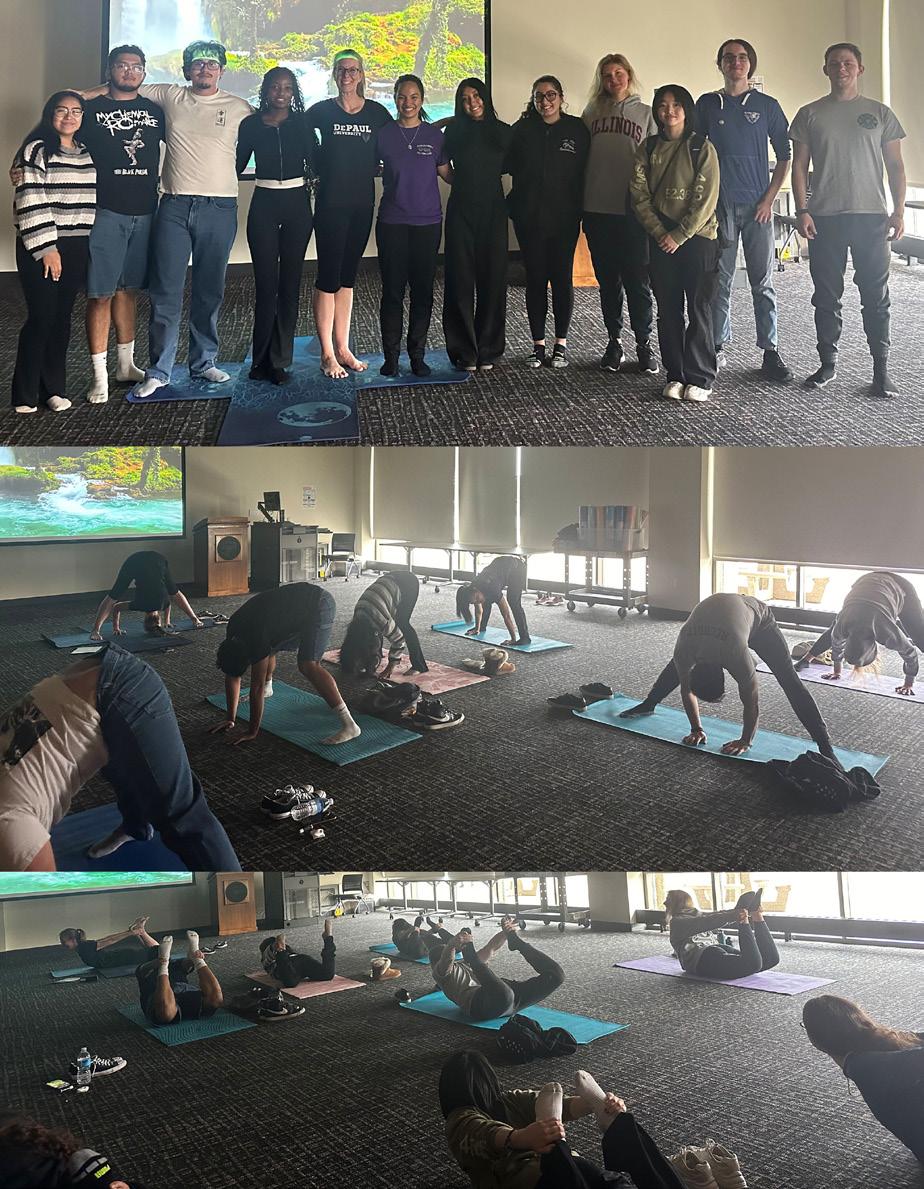
• Flexibility and Adaptability: Although we had a solid plan, things didn’t always go as expected. We had to remain flexible, adjusting our approach when necessary, whether it was finding better ways to promote workshops or adding new activities like the yoga session led by Dr. Heinrich. Adapting to these changes and overcoming unforeseen challenges made the process both challenging and rewarding.
Collaboration
The execution of our College Project focused heavily on strong communication and collaboration throughout each stage.
• Regular Team Meetings: Weekly meetings allowed us to track progress, align on goals, and address any issues. These check-ins ensured we were all on the same page and able to adjust if necessary.
• Adhering to the Project Plan: A detailed project plan served as our roadmap, ensuring that we stayed focused on promoting financial literacy, improving wellness, and enhancing the campus pantry.
• Effective Communication with Collaborators: We kept in regular contact with collaborators like KCT Credit Union, Dr.
Jennifer Maxwell, Ms. Andrea Hinojosa, and Dr. Heinrich to ensure everyone involved was informed and up-to-date.
• Promoting Workshops and Events: We used flyers, social media posts, and email announcements to spread the word about our workshops. Partnering with campus organizations like TRIO and Student Government helped extend our reach and connect with more students.
• Student Feedback and Surveys: We distributed surveys to collect feedback about the pantry and workshops. This information guided our decisions and helped us refine the pantry’s offerings to better serve student needs.
• Team Responsibilities: Every officer had specific responsibilities, such as promoting events, managing communication, and staffing the pantry. Having clearly defined roles ensured that everyone contributed to the project’s success.
• Flexibility and Problem-Solving: While the project plan provided structure, we remained flexible when issues arose, such as low event attendance or volunteer cancellations. We learned to adapt and overcome these challenges in real time.
Figure 1
Figure 2
Impact
Quantitative Outcomes
• Workshop Participation: We hosted seven workshops—three on financial literacy, two on yoga, and two on nutrition—with 89 participants. Many students expressed interest in additional budgeting sessions (Figures 1 and 2).
• KCT Credit Union Booths: 10 booths were set up across campus, offering students easy access to financial tools.
• Pantry Utilization: The campus pantry saw 1,328 visits and served 447 individual patrons, with 109 new applicants.
• Budget Planner and Wellness Kit Distribution: We distributed 51 budget planners and 38 wellness kits, including yoga mats, reaching 80 students.
• Survey Responses: 94 survey responses were collected, offering valuable insights into student needs and preferences (Figure 3).
• Volunteer Engagement: 3 volunteers helped foster a sense of community and engagement among students.
Qualitative Outcomes
• Student Feedback: Many students expressed interest in the workshops but struggled with scheduling conflicts. They requested more sessions at varied times. They felt more empowered to manage their finances and health and wanted continued workshops.
• Empowerment and Community Building: The project empowered students by equipping them with practical financial and wellness skills. It also helped foster a sense of community as students connected with resources and each other.
• Impact on Officers: For the officers involved, this project was a transformative learning experience. It enhanced our planning, communication, and leadership skills, deepening our connection to the college community.
• Strengthened Partnerships: We built stronger relationships with collaborators, including KCT Credit Union, wellness experts, and ECC faculty. These connections laid the foundation for future initiatives and collaborations.
• Increased Awareness: Workshops and events helped raise awareness about financial literacy, wellness, and campus resources like the ECC pantry, showing students these tools are essential for overcoming challenges.

3
Chapter–College Relationship
This project has not only strengthened our relationship with ECC’s administration but has also deepened our connections with faculty, staff, and fellow students. Working closely with ECC President Dr. Peggy Heinrich, along with key staff members from student life, wellness, student government, and the cafeteria, amplified the impact of the project.
Our relationship with our advisors has grown throughout this project. The bond among our officers has strengthened as we worked together, building trust and unity. We’ve been fortunate to collaborate with passionate speakers and instructors who directly shaped the success of this initiative. Professors like Dr. Farah Bennani, Dr. Chuck Dakarian, and Chef Stewart have already agreed to assist with future projects, and other faculty members have expressed interest in supporting our ongoing work.
Figure
Picture Yourself as a Pro: Professional Development for College Students
Gamma Nu Chapter
Mississippi Gulf Coast Community College – Perkinston
Perkinston, Mississippi
Abstract
Our college project, entitled Picture Yourself as a Pro, provided students with opportunities to learn more about an array of careers. Our college’s mission aims to develop dynamic students of excellence and achievement by providing career pathways. This project allowed students to speak individually with professionals from a variety of fields. Through these conversations, some students clarified their career goals, while others gained exposure to professionals from many different fields to add to their knowledge of what might be available to them in the future.
Students also received professional development opportunities, including free professional headshots. Some participants learned of internship and job opportunities currently available to them. Overall, this event met the administration’s desire to allow students to learn real-world information from current professionals about a range of careers, supporting the college’s mission of providing students with career pathways.
Planning
The Gamma Nu officers and advisors first met to review the college’s mission statement before meeting with the campus administration team. The chapter president scheduled a meeting with the campus vice president and his administrative team to discuss ideas for the project. During the meeting, administrators expressed interest in a
project to support the college’s vision of “inspiring excellence and accelerating achievement.”
College and chapter leaders brainstormed a project that would align with the administrators’ ideas to address this need. Administrators suggested creating an opportunity for students to learn more about pursuing their chosen careers. Building on that idea, we envisioned a career expo through which students could speak oneon-one with professionals from different fields, ask questions, and gather information specific to their interests and situations.
After this meeting, chapter leaders developed action items to be achieved, setting a timeline to complete the event on November 7. The officer team delegated tasks and asked faculty and administrators to suggest contacts in their networks that might help with the event. Officers booked the event location in the student union and collaborated with the manager of student activities to involve other student groups, such as the Student Government Association, to assist with the project. Once details were finalized, the chapter president relayed information back to the campus vice president for feedback and approval.
Leadership Development
Successful execution of the College Project required the officers to have proficient leadership skills in areas such as teamwork, professionalism, adaptability, and organization. The team began by completing PTK Edge courses and watching online videos outlining various leadership responsibilities and styles. By identifying and appreciating each officer’s different leadership styles, Gamma Nu leveraged individual strengths through efficient task delegation. By recognizing each other’s strengths, the officers improved their own skills with help from teammates who excelled in areas where they themselves wanted to grow.
Whether communicating verbally or digitally with administrators, staff members, professionals, students, or volunteers, chapter officers needed to maintain professionalism through speech and appearance. This was reinforced through a meeting focused on understanding how to write professional emails and communicate appropriately when making requests.
To provide students with a variety of careers and backgrounds for the event, our officer
team collaborated to recruit a diverse group of volunteer professionals. With scheduling conflicts or communication challenges that frequently arose, officers were required to adapt to setbacks to stay on schedule. Additionally, to keep track of the number of volunteers, the officers remained organized throughout the duration of the project. Organization helped the officers improve their methods by monitoring notes and meeting discussions, which aided in their efficiency because everyone was aware of which tasks were being completed by which team members. Through these various methods, the team members utilized and enhanced their leadership skills, enabling the successful execution of the project.
Collaboration
In their weekly meeting, chapter officers and advisors assessed the project’s progress, ensuring they were on schedule. During these meetings, members shared their setbacks and achievements to respond accordingly as a group. Additionally, the chapter communicated with the dean of teaching and learning throughout the completion of the project via email. Keeping the lines of communication open with the administration ensured that the project remained true to the college’s mission statement and the administrators’ vision for the overall objective.
Using email, text messaging, and social media, chapter officers contacted potential volunteers suggested by administrators, advisors, and members. However, the chapter was confronted with limited commitment through this recruitment method. Therefore, modifying the approach was necessary. They selected members of Gamma Nu’s alumni to participate, which was very successful. The chapter also asked college instructors to reach out to individuals within their networks who might participate. These adjustments led the chapter to successfully compile a sufficient number and variety of volunteers.
Prior to the event, the officer team maintained consistent communication with volunteers. In addition to providing the date, time, and location of the event, some communications addressed questions, offered suggestions for materials to bring, and outlined resources the chapter would supply. Additionally, to inform as many students as possible of the event, the chapter
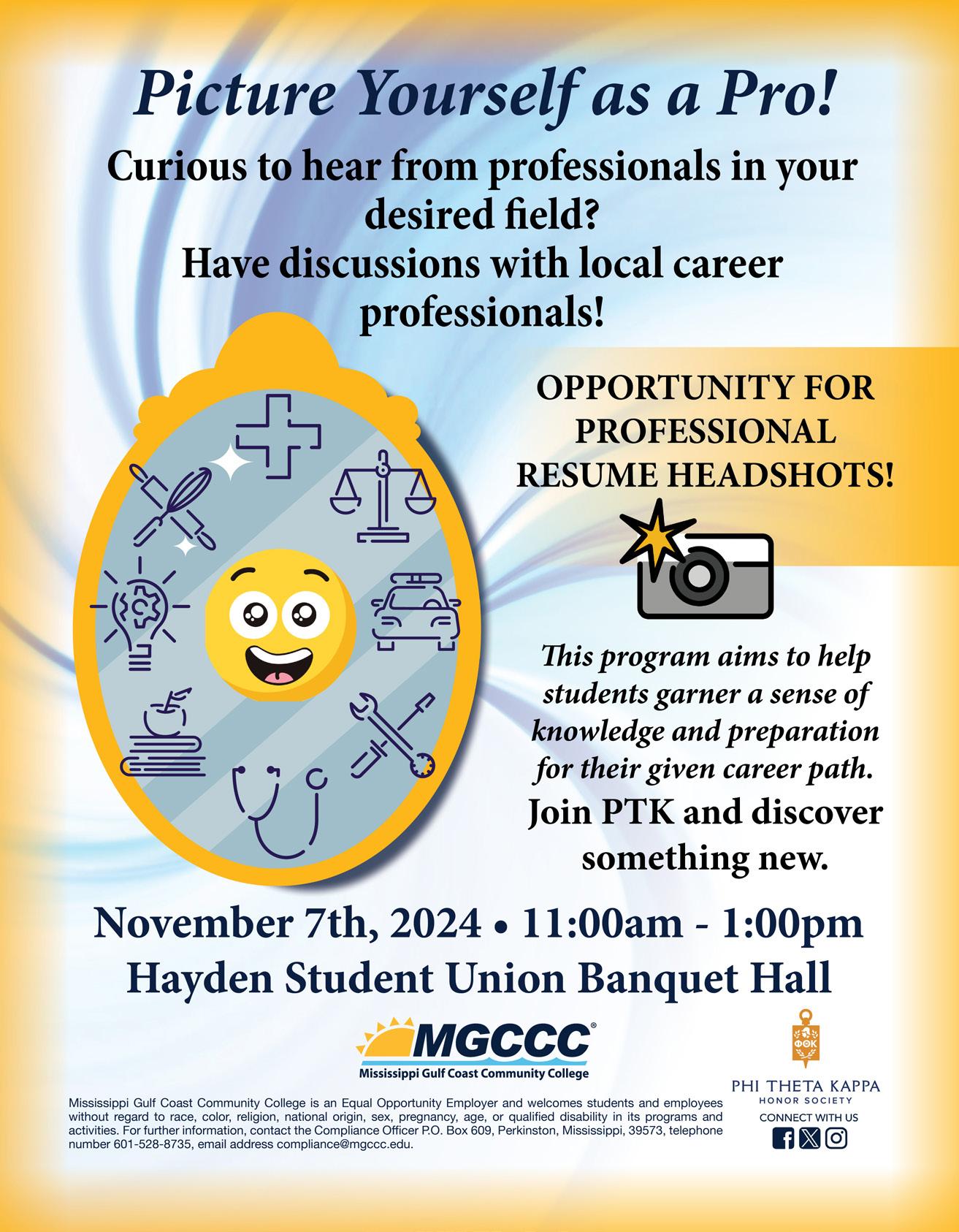
coordinated with the manager of student activities to send mass text messages to the student body in the weeks leading up to the event. Chapter officers also collaborated with the MGCCC Office of Public Affairs to create fliers (Figure 1), campus maps for volunteers, and keys to identify which careers were at the event and where each was located. Finally, to ensure student participation, the team brainstormed ideas such as offering extra credit and a raffle to incentivize student attendance and increase participation at the event.
After the completion of the project, the chapter organized the data collected and presented it to the administration. The administrative board was pleased with the outcome. Additionally, many volunteers expressed their interest in returning if the event were to be repeated in the future.
Impact
Picture Yourself as a Pro garnered a remarkable turnout, with 22 professionals from various fields—including 10 from business and pre-med professions—who volunteered to engage with the
approximately 170 students who attended the event. Additionally, 30 students took advantage of the résumé headshot service offered at the event.
Many students expressed their satisfaction with the event. A feedback survey concluded that roughly 70% of students attending the event learned something new about their desired career (Figure 2), and 80% of students gained a better understanding of the pathway to their career (Figure 3). These results showed that students gained valuable insight into their future careers and the paths required to get there.
Furthermore, students who were uncertain about their career goals were introduced to various career paths, enabling them to make informed decisions and refine their academic plans. This is suggested by Figure 4, which demonstrates that 75% of students discovered a new career path that differed from their original plan. This notion was also supported verbally by students who attended the event.
Some students conveyed their lack of interest in their desired career after interacting with someone in that field, leading them to research new career paths. On the other hand, many students were ignited with enthusiasm after their interactions with people in their future fields. The interactions allowed students to network and even gain experience through internship and job offers. One student left the event stating, “I have an internship this summer!” and continued to express how pleasing the interaction with the volunteer was.
The college’s administrators commended the chapter for its success and sparked conversations about continuing this project in the future. Volunteers also shared the same sentiment with the chapter; one volunteer expressed that she would want to be invited back if the project is repeated. Additionally, a significant 96% of students who attended and completed the survey hoped to see the project repeated and expanded in the future (Figure 5), while roughly 30% of students’ desired careers were not represented at the event (Figure 2). In the future, the chapter hopes to provide more volunteers from different career fields to increase career exposure for students and decrease this final number. The officers were very pleased with the success of the project, their personal growth throughout the execution of it, and helping their peers achieve excellence through clarifying their career goals.
Figure 1



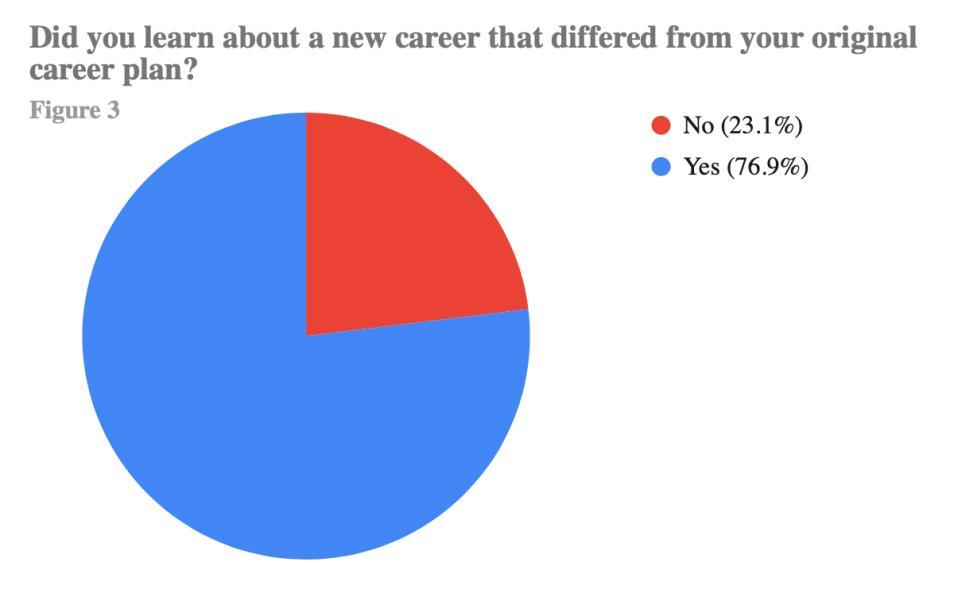



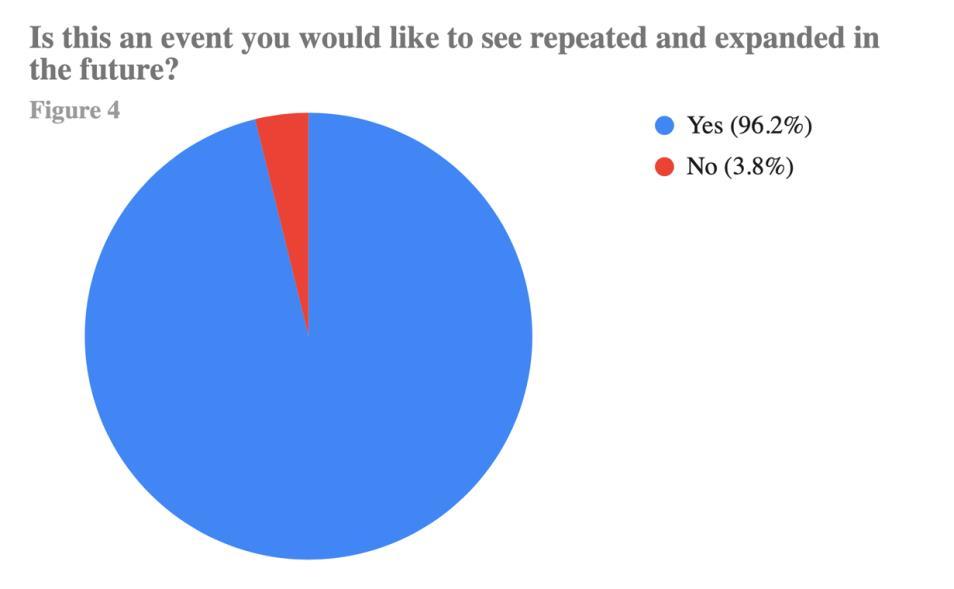
Chapter–College Relationship
This project has significantly improved the relationship between MGCCC’s administration and Gamma Nu. Due to this project, not only did the officer team form personal relationships with administrators, but so did the new chapter advisors and members due to their involvement. After this collaboration, the chapter and campus leaders frequently chat when they encounter one another on campus, which has given the chapter opportunities to discuss ideas for upcoming chapter meetings and events. As a result, the administration has prioritized attending events hosted by the chapter this year, and they continue to advocate for Gamma Nu. The college’s leadership has acknowledged the success of Picture Yourself as a Pro and its impact on the students, expressing their optimism about working successfully with the chapter in future endeavors.
Figure
Figure 4
Figure 5
The Roller Coaster Ride of Mental Health: Free Virtual Counseling for Every Twist and Turn
Alpha Delta Omega Chapter Glen Oaks Community College Centreville, Michigan
Abstract
Mental health is often compared to a roller coaster— where emotions fluctuate wildly (up one moment, down the next)—and it’s unpredictable, but there’s always the possibility of a smoother ride. Our first step in the College Project process was to familiarize ourselves with the heart of Glen Oaks Community College: its mission. The college’s mission is to provide opportunities for academic and lifelong success through excellence in teaching and comprehensive support services that cater to our community’s diverse educational needs.
Our project emphasized promoting free virtual mental health counseling services for students, driven by the understanding that mental well-being plays a huge role in academic success. This initiative wasn’t just an afterthought—it directly supported Glen Oaks’ mission by providing essential support services to help students manage stress, anxiety, and other mental health challenges that can derail their studies.
By offering easily accessible, confidential counseling, we ensured that students had a safe space to talk about their struggles and find solutions. This project aligns with the college’s commitment to creating an environment where students can thrive—not just academically, but personally as well—ensuring they have the tools to succeed in all aspects of their educational journey.
Planning
The planning process for our project kicked off with a deep dive into Glen Oaks Community College’s mission, which emphasizes opportunities for academic and lifelong success through excellence in teaching and comprehensive support services. To make sure our initiative aligned with these priorities, we carefully
reviewed the mission statement, zeroing in on the focus areas of support services and academic success.
Next, we gathered for a brainstorming session to generate ideas that would directly contribute to the college’s mission and address a pressing need within the community. Our top five contenders included mental health support, Title IX, planting a flower garden, creating a sensory room, and starting a book exchange. After some discussion, we chose mental health—something we knew could make a significant difference for students.
Just as a roller coaster has its peaks and valleys, students experience emotional highs and lows throughout their academic journey. Mental health support can help them stay grounded through the challenges of college life. We set our sights on the next step: presenting our proposal to the vice president of student services. Before the big meeting, we gathered data on student mental health needs, assessed current campus resources, and researched best practices for virtual counseling services. We wanted a proposal that was not just based on a hunch but backed by solid data and proven methods.
When we met with the vice president, we confidently shared our findings, emphasizing how our proposal aligned with the college’s mission and how a virtual mental health service could significantly improve student well-being. The vice president was on board and supportive of the idea, and we agreed to move forward with the project. Her feedback was invaluable; she suggested we promote the newly rebranded UWill Virtual Mental Health Counseling service and recommended collaborating with Disability Support Services to develop “mental health first aid” training for students.
Given permission to proceed, we moved into the planning phase. Our focus turned to logistics— determining the best ways to promote the service and create an effective marketing plan to ensure student awareness. We also discussed integrating the counseling information into New Student Orientation to ensure that incoming students knew about this important resource.
Through thoughtful collaboration and careful planning, we prepared a project that directly supports Glen Oaks Community College’s mission by providing comprehensive support that would help students succeed both academically and personally.
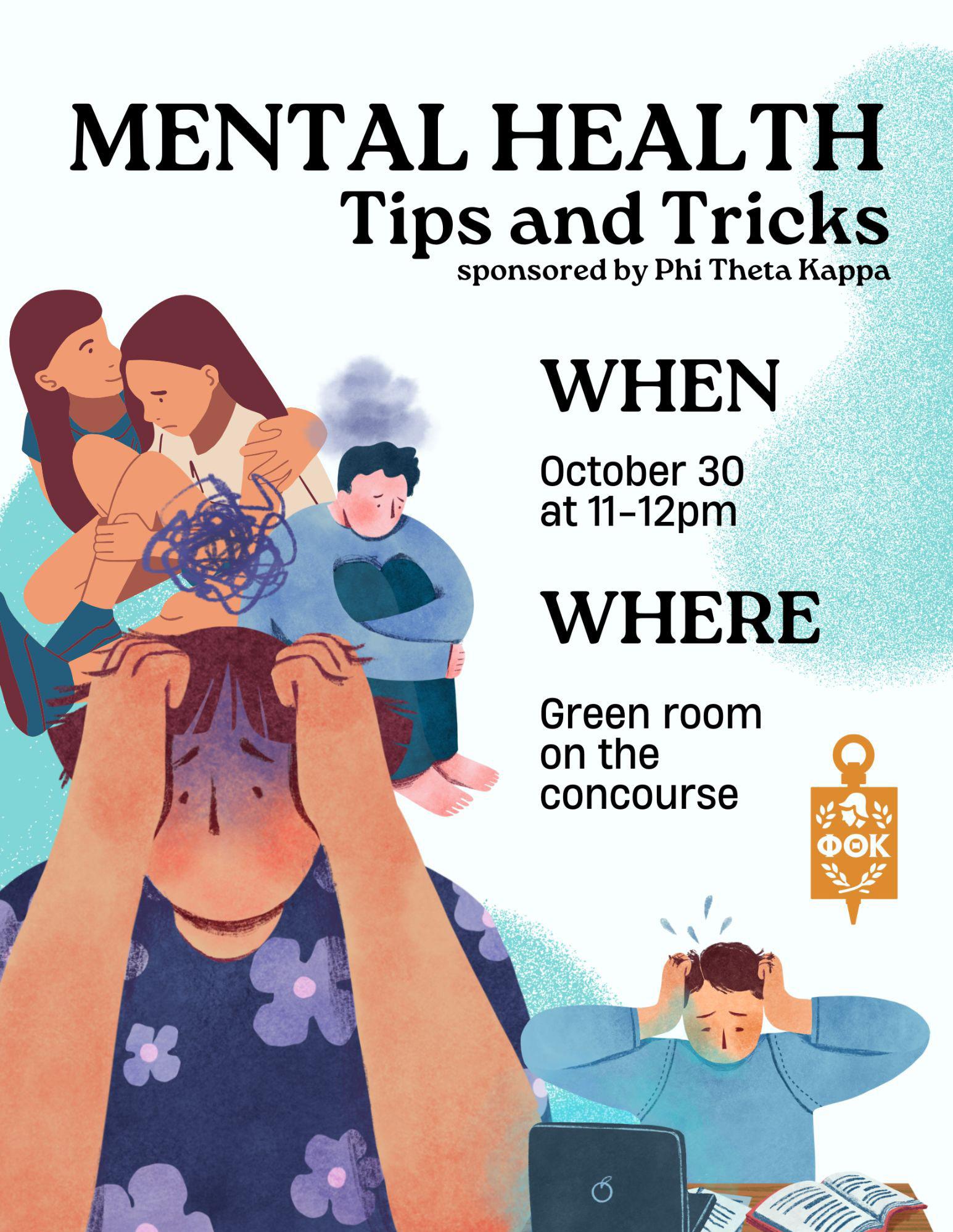
Leadership Development
To promote free virtual mental health counseling, our team needed a range of skills. We began by researching mental health challenges students face— like stress and anxiety—and how they affect academic success. We also familiarized ourselves with existing resources and virtual counseling options to craft a strong, evidence-backed proposal.
Aligning our project with Glen Oaks Community College’s mission was key, so we made sure our initiative supported both student well-being and academic success. We viewed the virtual counseling service as a safety net, offering crucial support during emotional challenges.
To ensure students knew about the service, we developed a marketing plan using UWill’s materials, including posters, social media posts, and flyers. We participated in digital marketing workshops to refine our messaging. One team member coordinated with Disability Support Services to create a “Mental Health Tips and Tricks” session (Figure 1), strengthening her event planning skills.
Figure 1

Through research, training, and collaboration, we built the skills needed to successfully launch the project—helping students access the support they needed while enhancing our leadership abilities.
Collaboration
The chapter pulled off a successful campaign to promote the UWill Virtual Mental Health Counseling service, using a strategic, multichannel approach to reach as many students as possible. The team made sure students both heard about and knew how to access the service.
We started by identifying the best ways to get the message out, using digital platforms like social media, email, and the student portal, as well as posters in high-traffic campus spots. We also involved faculty, staff, and student groups to amplify our reach.
Working with UWill, we created vibrant posters, eyecatching flyers, and engaging social media content
to highlight the service’s benefits—easy access, confidentiality, and flexibility. We posted materials around campus and scheduled posts on Instagram, Facebook, and Twitter. We also teamed up with Student Activities to send email blasts with clear signup instructions.
During high-stress times like midterms and finals, we placed more materials in key areas and hosted a “Mental Health Tips and Tricks” workshop in collaboration with disability support services. Behind the scenes, we stayed in close contact with our team, faculty, and administrators—tracking progress and keeping everyone updated. As the semester wrapped up, we celebrated with a “Phi Theta Kappa Lunch and Learn,” showcasing the success of the project and presenting survey results (Figure 2) to highlight its positive impact.
Impact
Like a thrilling roller coaster, college life is full of highs, lows, and unexpected turns. Mental health counseling provides the guidance students need to enjoy the ride without being thrown off track. We found this through our quantitative and qualitative outcomes.
Quantitative:
• 12 users on the previous platform
• 33 registered users on UWill
• 26 active users on UWill
• 70 survey responses
• 80% of respondents said they would use the platform if needed
Qualitative:
The project had a profound impact on raising awareness about mental health, fostering personal growth, and deepening the understanding of the challenges students face. This was especially transformative for chapter members with limited previous exposure to mental health topics. One officer shared that attending the “Mental Health Tips and Tricks” session opened her eyes to the struggles many experience, particularly during the holidays. Although she had never personally faced this challenge, she now recognizes the emotional toll it can take and is committed to reaching out and checking in with others during the holiday season. This personal shift underscores the project’s wider impact on both individual members and the college community.
Figure 2
Chapter–College Relationship
This project significantly strengthened the chapter’s relationship with the college administration by fostering open communication, collaboration, and a shared dedication to student well-being. Through the creation of a thoughtful, well-researched proposal that directly aligned with the college’s mission, the chapter demonstrated a clear understanding of student needs and the capacity to execute impactful initiatives. While building trust with the administration, we also established the chapter as a proactive, solutionoriented partner in enhancing student services.
Throughout the project, the chapter maintained transparent, ongoing communication with the vice president of student services and other key administrators. Actively seeking feedback and working collaboratively on necessary adjustments ensured the project adhered to college policies and priorities, creating a sense of shared ownership and teamwork.
The project directly supported the college’s mission to provide comprehensive student support, positioning the chapter as a vital ally in promoting student success. This alignment helped the administration see the chapter not merely as a student organization but as a strategic partner capable of addressing critical student needs.
With the project’s success, we have paved the way for long-term collaboration with administration. It showcases the chapter’s ability to manage significant initiatives, establishing a foundation for future partnerships on mental health and broader student services. Additionally, the project encouraged stronger connections with administrators, empowering the chapter to confidently engage with them.
College life—much like a roller coaster—has moments of rapid changes and emotional loops. Mental health services help students navigate these moments with greater stability and confidence. In essence, this project deepened the chapter’s bond with the administration, positioning it as a key contributor to the college’s mission and highlighting the value of studentled initiatives in fostering academic success and supporting overall student well-being.
Making the Most of Calhoun: A Student’s Guide to Campus
Sigma Lambda Chapter
Calhoun Community College
Huntsville and Decatur, Alabama
Abstract
Our project entailed writing, filming, and distributing three short videos about our college for students. We showcased these on our school website, our chapter’s social media pages, and distributed them to 840 students in orientation classes. Our videos covered three topics:
• “All About Accessibility” featured the director of student disability services (Figure 1), who discussed accessibility at our college and how to access mental health services.
• “Student Clubs and Organizations” informed students about opportunities for engagement on campus, including raising awareness for organizations that promote diversity (Black Student Alliance, Neurodivergent Club, International Club, Hispanic Student Association, etc.).
• “Campus Wars” focused on the unique features of each of the college’s four campuses and discussed the benefits of each.
A primary objective for our College Project was to ensure it aligned with our college’s mission and vision statements, which we reviewed prior to our meeting with administration:
• Mission: “Promote student success and community development through quality education, cultural enrichment, and workforce training.”
• Vision: “Success for every student, the community, and the college.”
The videos we created met the student success objectives set forth in these statements. Campus Wars provides students with much-needed information about the differences between our campuses. This is often a source of confusion for students, and our video will help them make informed choices about where and in what format to take their classes. All About Accessibility


gives students with disabilities and/or those in need of mental health support important information about accessing resources at our college, which in turn will help them be more successful. Student Clubs and Organizations will help provide cultural enrichment, as specified in our mission statement, by encouraging students to get involved in diverse organizations on campus.
Planning
To begin, officers and advisors reviewed requirements for the project and our school’s vision and mission statements as a group. We brainstormed project ideas related to those statements and known college priorities.
Officers and advisors met with the college president, vice president of academic affairs, and vice president of student services. We reminded administrators of the purpose and parameters of the College Project and shared our initial project ideas, all with a focus on supporting student success. Each administrator then discussed their own priorities, which included: a project focused on student engagement, a project focused on campus accessibility, and short peerto-peer videos for students about frequently asked
questions. Everyone liked all of these ideas, so we mutually agreed to combine them into one project: creating short videos about clubs/organizations, accessibility, and campus overviews.
Leadership Development
Before implementing our College Project, we identified several skills we needed to strengthen and took deliberate steps to do so. Since we knew we would be presenting on camera, public speaking was a focus for improvement. We honed our abilities through practice, including presenting at chapter meetings, to several classes at our college about PTK (Figure 2), and to roughly 100 participants at a PTK regional event. We further refined our speaking abilities with voiceover practice and received feedback on our delivery from a speech instructor. Additionally, a PTK member with video production knowledge provided feedback on timing and script delivery. Three project participants also improved their public speaking skills through completion of PTK’s Competitive Edge program.
Video creation and editing were also major components of the project, requiring technical skills we developed through training sessions with our college’s public relations department. We improved our script-writing abilities by seeking feedback on our scripts from a PR staff member. We also received training from PR to operate equipment, including cameras, tripods, microphones (boom and lapel), and teleprompters, as well as DaVinci Resolve (video editing software). Because we knew professional framing was important, we practiced setting up spaces for video shoots, focusing on lighting, angles, and staging (Figure 3).
We also knew teamwork would be critical to the project’s success, so we worked on strengthening those skills through team-building activities at our officer training retreat. Since our team members attend different campuses with widely varying schedules, critical thinking was needed to coordinate filming and training days. We found times that worked for everyone through effective and frequent communication. Flexibility and problem-solving skills were also necessary during filming to make on-thespot adjustments due to challenges like lighting, noise, and hallway traffic.
Collaboration
We first determined how many videos to make and what each would cover. Members brainstormed topic ideas at chapter meetings and selected three based on administration’s input. The officer team then
Figure 2
Figure 1

assigned roles and delegated tasks, including script writing, coordinating with collaborators, and promoting the videos on chapter social media platforms. Once roles were assigned, we began production.
We contacted the college’s PR department to discuss the project and receive training. After our initial meeting, we drafted video scripts and submitted them to PR for feedback. PR then trained us to use the college’s recording equipment, and we scheduled a date to film. We filmed the videos ourselves, including a guest appearance from the director of student disability services, with whom we coordinated via email. After recording, we edited the videos and added music and b-roll from the college’s collection. We then distributed the final videos on our chapter’s social media and emailed them to the director of advising for inclusion in the required orientation class.
To maintain communication with college administration, we sent regular email updates and asked for feedback to ensure we were aligned with the college’s expectations. Our final email update included links to the finished videos, the number of views on social media, and details about plans to share the videos in orientation courses.
A major challenge we encountered was the loss of our VP of College Project partway through the process. To keep the project moving, the chapter president stepped in to lead, and other officers took on additional responsibilities. We used a shared Google Drive to store scripts and videos and track our progress, and GroupMe to communicate as a team. The College Project team also scheduled and attended meetings outside of regular chapter meetings, including with the PR department. Members gave regular project updates at chapter meetings.
Impact
The qualitative and quantitative outcomes of our project show that we achieved our goal of giving students an accessible way to learn important information about the college. We posted the videos on chapter social media accounts with a combined 871 followers and received a total of 1,064 video views. The videos were also presented to 840 students in orientation classes. This broad distribution ensures that the 20,000+ students who enroll at our college each year will have the information they need to be more successful.
Our project also supported a key administrative priority—student engagement—by encouraging chapter involvement in video production. We shared project updates and involvement opportunities with our 1,072 chapter members through our LMS and chapter meetings. One member was named Member of the Month for his dedication to the project.
The project helped us grow professionally. We strengthened project management and creative problem-solving skills (like using editing to work around equipment issues). We also developed professionalism by working with college administrators and staff and learned how to build strong, collaborative relationships.
This project also helped us grow as scholar-servantleaders. We worked hard to create videos that met the needs of diverse students and reflected the priorities of our administration. We learned to think beyond our own experiences and design a project that would truly benefit our audience.
Chapter–College Relationship
Our project strengthened our relationship with college administrators by giving us the opportunity to learn from their experiences and incorporate their ideas into our project.
It also allowed us to build relationships with two new administrators who were aware of PTK but unfamiliar with our major initiatives. This gave us the chance to show that PTK is more than a line on a resume—we are student leaders who care deeply about supporting the college’s goals.
We also formed new relationships with college staff. Before this project, our chapter had never worked with disability services or the PR department. This collaboration gave us the opportunity to leave both departments with a positive impression of PTK, and open the door for future partnership.
Figure 3
Green Minds: Students Feeding the Future
Iota Xi Chapter
UCNJ
Union College of Union County, NJ
Cranford, New Jersey
Abstract
The Iota Xi Chapter’s College Project was designed to support Union College of Union County, New Jersey’s (UCNJ) mission of “transforming our community one student at a time” and its values, which reinforce student success, student resources, and student support services. We specifically aimed to fight against food insecurity by adding to the current resources UCNJ has in place—a farmers market and food pantries.
Research indicates that “In New Jersey, about 8% of people are food insecure, but on college campuses that number is far greater, closer to 30%” (Caloway). Moreover, a UCNJ Instagram post (2024) revealed that 50% of UCNJ students are concerned about running out of food before they can afford to purchase more. Therefore, UCNJ has made fighting campus food insecurity a priority. The chapter and college administration met and agreed that supplying their current resources with fresh and nutritional food for students could reduce stress regarding food insecurity and allow them to have better academic performance. Additional benefits included removing feelings of isolation and embarrassment that students facing food insecurity might feel. It also gave volunteers a chance to learn something new about fresh produce and help give back to the college and their fellow students. In support of this decision, a plan was developed to provide fresh produce using the college’s hydroponic systems to supply the food pantry and the college’s farmers market.
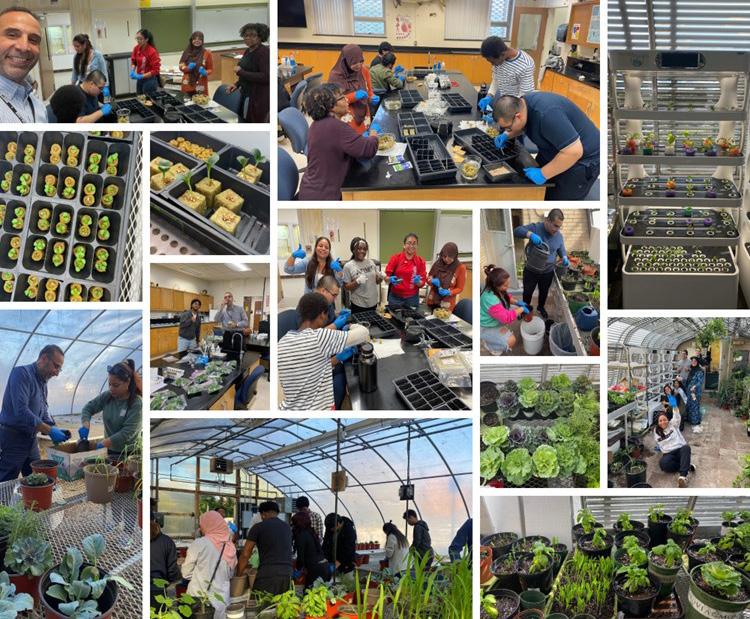
References:
Caloway, N. (2023, November 15). Pantries provide peace of mind to college students dealing with food insecurity. CBS News. https://www. cbsnews.com/newyork/news/pantries-providepeace-of-mind-to-college-students-dealingwith-food-insecurity/
Union College of Union County, NJ. (2024, December 3). Help feed our students this Giving Tuesday. Instagram. https://www. instagram.com/ucnj_owls/?hl=es
Planning
Our chapter is fortunate that our college president allows us to select and present ideas regarding possible College Projects. Determining this year’s project started with membership meetings during the spring semester to discuss issues and concerns that students faced on campus. Two topics were highlighted during the discussion:
• Food insecurity and providing help for students who need a good meal, and
• Providing resources for students to connect their majors to the reality of the workforce.
The service team met with UCNJ’s social workers to discuss what issues were a priority for students regarding food insecurity. The social workers shared
that they wanted to provide more variety at the food pantry for students to have while on campus and to take home. We discussed collecting donations from local restaurants and supermarkets but also had the idea of growing our own vegetation on campus. We then had a meeting with the director of student research, who introduced the possibility of using hydroponics to grow food to help supply the college’s food pantry.
We also explored our second option by determining the top five majors at the college and identifying contacts in the career services office to plan panel discussions with professionals so students could learn more about their career choices.
Based on our research and meetings, we created a PowerPoint presentation for the PTK officers to receive their feedback on both options. After further research, multiple discussions with the advisors and service team, and considering UCNJ’s focus on food insecurity, we chose that topic as our potential College Project. A meeting with the president and core administration was set, and the team presented the idea of growing fresh food hydroponically on campus. Our administration approved, gave feedback (including ideas on which vegetables to grow), and offered assistance if our team needed it. The service team then presented the College Project Green Minds: Students Feeding the Future to our general membership to raise awareness and recruit potential volunteers.
Leadership Development
The College Project was led by the vice president and committee leader of the service hallmark. The primary focus of the project was using the campus hydroponic systems to provide fresh nutrients to our college’s food pantry and farmers market.
Hydroponics is a type of horticulture that involves growing plants without soil, using water-based mineral nutrient solutions. This method leads to greater production with lower water requirements. Before beginning the process, it was essential that our service team acquire basic knowledge about the use of the hydroponic systems and plant care. This included an understanding of nutrient cycles and plant health management.
Therefore, our team met with the director of student research and were taught how the hydroponic systems worked and how we would care for the
Figure 1
plants. We then presented alongside the director at a general PTK meeting to get volunteers for this project. In this meeting, we brought samples for members to see and gave them a chance to ask questions regarding the project.
Volunteers were separated into two groups and received an orientation with the director on hydroponics, how the systems are used, how to correctly plant the seeds, the importance of the rock walls to initiate growth, and how one would water or give nutrients to the plants (Figure 1). The project leaders strategically devised a plan to have multiple harvests as well as a volunteer plan so that there was complete coverage for the growing vegetation. The volunteers were taught the importance of commitment and taking responsibility when it was their turn to water or give nutrients to the growing plants. Importantly, everyone involved in the project learned how to strengthen their communication and collaboration skills to create a successful project.
Collaboration
From beginning to completion of the project, we maintained constant and effective communication with all collaborators, including advisors, students, clubs, and social work staff. We used tools like weekly emails and text messages to coordinate meetings and track the progress of plants in the greenhouse. Emails were used for detailed updates and task reminders, while text messages were used for quick confirmations and immediate reminders.
We held meetings to provide deeper and broader knowledge about hydroponics and horticulture. In addition, the active participation of the Sustainability Club helped us throughout the entire process of transplanting the plants and harvesting, which doubled our volunteer numbers. We also contacted the Architecture Club to design a trellis support that would facilitate the growth of the plants.
Just before the first harvest, our officers participated in a college-wide radio program to update, inform, and motivate the UCNJ campus about Green Minds: Students Feeding the Future (https://www. uccr.info/union-grows). We discussed the details of the project in depth, highlighting the importance of the greenhouse, the progress made, and the contributions of each member, which helped to strengthen commitment and collaboration within the team (Figure 2). A final tally of students served was shared with the president and the

administration, encouraging the possibility to continue the project.
Impact
During implementation of the project, favorable results were obtained both qualitatively and quantitatively. Despite being a long project, the volunteers maintained a high level of interest from the beginning. Participants learned the entire process related to the hydroponic system, developed patience and perseverance during the stages of planting, watering, and harvesting of vegetation, and, thanks to their efforts, they managed to help other students combat and reduce stress caused by food insecurity. This support provided students with better nutrition, which may have helped them to be more focused on their studies.
We conducted two major harvests of herbs and vegetables, including basil, rosemary, lettuce, kale, and tomatoes, among others. Our first harvest became part of the food pantry’s Thanksgiving baskets to students. We supplied fresh vegetation to 25 students and their families. A few weeks later, working with the social work staff, a farmers market was organized where more than 150 students benefited thanks to the effort and dedication of the volunteers (Figure 3).
We not only were able to supply fresh food ready for consumption, but we also provided 55 tomato plants that students could take home for continued nutrition. Each bag of vegetation included the
Figure 2
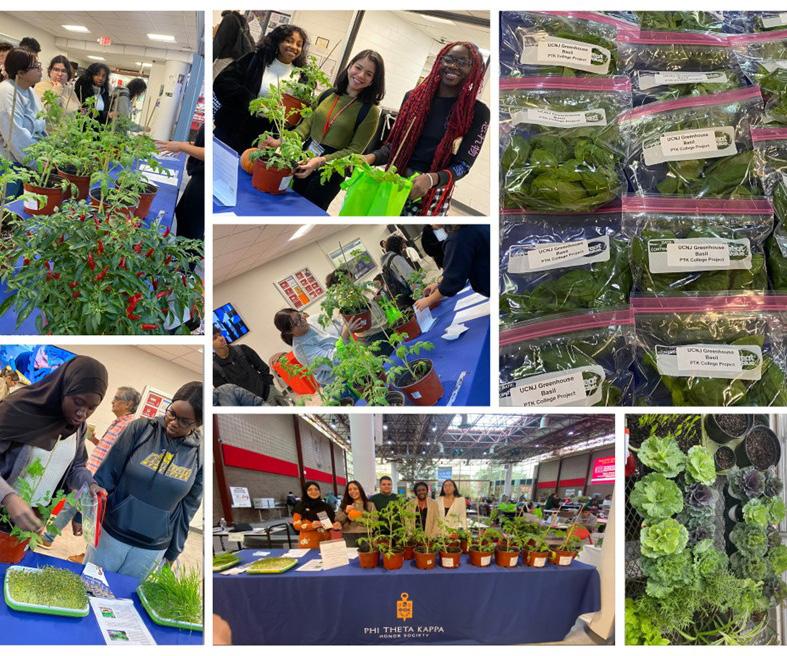
nutritional value of its contents. We also supplied students with samples of microgreens that can be grown quickly and have high nutritional value. Many students were excited to have the opportunity to grow food in their own homes.
This project was also an opportunity for volunteers to develop empathy, as they reported that they were able to understand firsthand the reality of many students facing food insecurity. In addition, volunteers created friendships with each other and became active in more campus activities.
Long term, the project is expected to expand and continue under subsequent leadership. Current volunteers will train and mentor new students, with the possibility of expanding to all three UCNJ campuses.
Chapter–College Relationship
During a meeting with the administration, it was clear that the College Project aligns with the institution’s mission of “transforming our community one student at a time.” By focusing on each student, we can address the larger needs of the community. We agreed that students cannot achieve their goals and dreams if they do not have proper nutrition and are stressed about where their next meal is coming from. For this reason, ensuring they receive the necessary nutrition is a priority for UCNJ.
Moreover, observing the positive impact that the College Project has had, where many students had access to fresh vegetation, the administration, in collaboration with the Union County Foundation Nourish the Future, is evaluating the creation of a community garden. This project would offer all UCNJ students access to fresh and nutritious food, which would relieve stress and contribute to improving their academic performance.
In this way, we would not only be ensuring a brighter future for our students but also for our entire community. We are happy to report that the success of our semester-long collaboration has planted the seeds for a much broader impact.
Figure 3
Assessing Demand for On-Campus Drop-In Childcare Services
Beta Gamma Pi Chapter
Yavapai College
Prescott, Arizona
Abstract
The mission of Yavapai College is to provide quality higher learning and cultural resources for the diverse populations of Yavapai County. Our college aims to equip students with the tools they need to be successful regardless of their circumstances, providing foundation and guidance. Our project connects to the mission by identifying an obstacle the student population faces and providing a cultural resource for that population of students, enabling them to pursue higher education. The chapter officers, advisors, provost, and president met to identify the project and address the needs of students. From that meeting, our chapter was asked to conduct a survey of the college population to determine the need for and obstacles to drop-in childcare.
Planning
The planning process to investigate the need for a drop-in childcare option began during a strategic meeting involving the chapter and members of the college administration. This partnership demonstrated that college leaders were dedicated to meeting student needs, especially regarding childcare, which directly aligns with Yavapai College’s mission.
The chapter was tasked with determining the demand for flexible, drop-in childcare services. To gauge interest effectively, the College Project team decided to employ a survey as the primary data collection tool. The team set specific goals for the project and the survey and developed a timeline to guide the project’s progression. These goals included weekly meetings to discuss the process and progress, creating survey questions, evaluating results, and receiving in-depth feedback from students and employees as a true reflection of needs.
Members collaborated with the director of institutional research (IR) to ensure the survey was comprehensive and
effective. The IR director provided valuable insights and expertise in survey design. This partnership strengthened our approach and ensured we captured the necessary data for our project.
In subsequent meetings, members discussed options and strategies for the project to present to the college president. Throughout this planning phase, members worked to connect the project to the college’s mission of supporting diverse populations, ensuring that every step aligned with the overarching goals of the institution. The members established the goals for the survey and concluded that the project would be considered successful if we achieved a 2% response rate. Students, faculty, and staff were included in the data collection.
Leadership Development
Various knowledge and skills needed to be gained and implemented for this project. First, members developed their research, communication, and analytical skills. This began by investigating whether a need for dropin childcare exists in the greater community and identifying which daycares offer this service. Individual members took on leadership roles for this task. We used effective communication techniques, including standardized questions, to reach out to daycares within a 20-mile radius of the college. The goal was to determine whether these daycares offered drop-in services, along with their costs and available hours. This task revealed a void of services, with only one center offering limited drop-in care.
Next, team members worked to develop the survey for the college population. Students showed leadership in researching how to create a survey and working with the IR director to design an effective tool. The team collaborated to discuss the population’s needs and then worked to deliver the survey effectively. The team scheduled additional meetings to review and discuss results, creating formal documents and a PowerPoint presentation for the final report to the president.
An important skill developed among members was the ability to manage and overcome obstacles. An issue arose with the software the team and IR director had identified for the survey. Initially, the surveys were to be sent using this popular tool; however, a glitch prevented surveys from being sent from any college email account. The IR director attempted to work with the external company to find a resolution, but they were unresponsive. Ultimately, the team brainstormed and discovered a way to send the surveys without using the original tool. While this delayed the project, it
taught members the importance of teamwork, creative problem-solving, and persistence.
Through their leadership roles in the project, students experienced significant personal and professional growth by taking on responsibilities that extended beyond their classroom experiences. As members collaborated to design and implement a survey to gain insight into enhancing the academic environment for fellow students, they honed essential skills such as communication, problem-solving, and teamwork. The survey results deepened the team’s understanding of our college’s needs and allowed collaboration to foster initiatives that will help enhance the academic experience of their peers.
Collaboration
The project was instrumental in building strong communication skills and lasting partnerships. Initially, team members worked collectively to determine tasks, establish roles, and identify goals. The team collaboratively developed survey questions and sent them to the IR department for refinement. With the guidance of the IR director, members crafted and improved the questions to assess the need for drop-in childcare.
Through discussions with IR and administration, the team concluded that the survey should be sent to students, faculty, and staff to ensure the project provided a comprehensive overview of the campus’s needs. The survey included both open- and closedended questions to gain a broader understanding of the topic. Throughout the project, the chapter maintained open communication by providing regular updates. Team members met weekly to organize and execute the project and frequently communicated with IR. Members discussed questions, approaches, and how to manage challenges. They also worked together to overcome barriers that arose during the project.
Impact
The project goal was to survey and determine the need and interest in having drop-in childcare as an offering on our main campus. The project survey yielded impressive quantitative outcomes, with 214 surveys completed among faculty, students, and staff. Notably, 81.3% of students expressed interest in the service, reflecting significant demand. Additionally, 52.8% of staff and 57.1% of faculty indicated interest, showcasing broader appeal across the college community. The data also revealed that 90.9% of respondents would use the drop-in service regularly
or several times a week, illustrating the potential for strong engagement.
When reviewing the qualitative data, feedback highlighted significant unmet needs. Comments such as, “The FEC is far too expensive for normal employees and students,” underscored the desire for affordable childcare options that could enhance attendance and retention. (Note: The FEC is the on-campus full-time daycare.) Students also shared how the lack of childcare options affects academic performance. One respondent stated, “I miss out on needed tutoring because my only chance to go is while my kids are at school.” This feedback illustrates the potential impact of the service and highlights the meaningful challenges faced by our local college community.
The outcomes of this project align well with the college’s goals of supporting student success and enhancing employee retention. The project addresses the need for childcare and promotes an inclusive environment where students and staff can thrive. Working on this initiative from the beginning and providing effective, substantial feedback has strengthened the chapter’s relationship with the college, showcasing our commitment to addressing student and employee needs.
Chapter–College Relationship
This year’s project was to determine whether a need exists for a drop-in childcare service on campus. From the beginning, the project strengthened the chapter’s relationship with the administration, which trusted that our chapter would complete the project effectively and efficiently. This initiative aligned directly with the college’s mission to provide quality higher learning and cultural resources for the diverse populations of Yavapai County.
Before meeting with the administration, chapter members reviewed the college’s mission statement and priorities to ensure the project aligned with institutional goals. At the end of the semester, we held a productive meeting with the college president and provost, during which we discussed our survey findings and shared that the results indicated a high demand for drop-in childcare. The president indicated that this was valuable information and asked for the chapter’s assistance in gathering additional data as the initiative progresses. This collaborative approach fostered trust and demonstrated our commitment to helping the administration address the needs of the college community.
Benefits of Campus Daycare from Survey Comments:
• Improve access to education and work-life balance
• Safe, quality care to keep parent’s mind at ease
• Enhances employee retention
Our chapter took on a significant leadership role in this project. We used strategic thinking to analyze survey results, highlighting that 81.3% of students, 57.1% of faculty, and 52.8% of staff expressed interest in on-campus drop-in childcare services.
Members’ leadership roles included developing the survey, meeting with administration, and investigating current local options. We demonstrated critical thinking and proactive planning by presenting a detailed report outlining the demand. This experience also motivated chapter members to participate in leadership development activities, such as researching and learning how to conduct statistical analyses. The project relied heavily on data, so members were fortunate to work under the guidance of the IR director, who helped foster and enhance organizational and data analysis skills. The project fostered a strong sense of shared responsibility.
Throughout the implementation of the project, we maintained open lines of communication with the administration, providing regular updates and seeking feedback. The administration appreciated our efforts to align the project with institutional goals, reinforcing a cooperative spirit between our chapter and college leadership.
Both quantitative and qualitative data supported the outcomes of our project. The survey results demonstrated a clear need for drop-in childcare, with cost identified as a critical factor—information that provided valuable insight to the administration. Additionally, participant comments highlighted the positive impact this service could have on student success and access to education, further aligning with the college’s mission.
Shaping Student Leaders for a Brighter Future
Psi Psi Chapter
Brazosport College
Lake Jackson, Texas
Abstract
To support Brazosport College’s mission of student success and lifelong learning by responding to student needs, creating a dynamic and safe learning environment, and enriching our community, our chapter collaborated with campus departments and a nonprofit to host a one-day leadership conference. The project aligned with College President Dr. Vincent Solis’ 2024 community engagement initiative on leadership and promoted the benefits of community college to high school students. Local high school students, particularly those in student organizations, were invited to attend. Our chapter organized keynote speakers, breakout sessions, a resource fair, and professional headshots. Dr. Solis and Meredith King, CEO of True to Life Ministries (TTLM), delivered keynote presentations on leadership, and chapter members, along with other student organizations, volunteered at the event. The Leadership Summit, held on November 13, 2024, successfully hosted over 90 attendees, including students from two high schools and Brazosport College.
Planning
Our chapter met with Dr. Solis on April 2, 2024. We discussed leadership development and soft skills for college graduates and expressed interest in an outreach event to promote community college to local high school students. Dr. Solis suggested a one-day leadership event that could be promoted to local high school principals. A follow-up meeting with Dr. Solis and Vice President for Financial Services and Chief Financial Officer Ginger Wooster was scheduled, and our chapter presented a prospective event
agenda, budget, and workshop ideas. Both praised the organization of our presentation and approved our plan, pledging a $10,000 institutional budget to support the project—more than we requested.
Next, our chapter met with internal collaborators recommended by Dr. Solis, including the career pathways coordinator, dean of school and college partnerships, director of marketing, director of student life, and director of educational support and dual enrollment pathways. In a July 2024 collaborative meeting, we discussed logistics, marketing, event names, workshop ideas, and keynote speakers. Another update meeting included Dr. Solis and Vice President for Academic Affairs Dr. Monique Baucham, who volunteered to lead a breakout session. We created kits for each attendee, which included the draft event schedule, budget, and letters for principals and teachers. That summer, we also collaborated with the marketing team to develop a logo and attendee swag.
In fall 2024, our chapter began promotional outreach (Figure 1). A registration deadline of October 16 was established, and invitation letters were sent to area high schools, including private schools and homeschool groups. We planned event catering, secured a campus venue, coordinated with campus security for bus parking, and worked with marketing on a professional headshot booth. We also recruited our first keynote speaker, Ms. King. Our chapter met with her to discuss keynote topics. Her presentation focused on servant leadership and the theme “You Belong,” which encouraged attendees to believe in themselves as future leaders. We also invited Dr. Solis to serve as our second keynote speaker; he agreed to share his top ten tips for student leaders.
As the event neared, our chapter prepared a script for our officer team and planned an hour-by-hour schedule. We handled venue setup and decorated the space. We coordinated with collaborators to host a resource fair during the event, featuring career services, student organizations, and TTLM to provide information about campus and community resources for prospective Brazosport College students. We also set up an activity area with Connect Four and Jenga. In addition, we coordinated with our PTK members, the Student Government Association, and the Black Student Union to serve as event volunteers. Lastly, we finalized details with our breakout session leaders: Jeff English, career services coordinator, hosted a session on résumés and interviews; Dr. Tori Amason,
This student-led conference will be a valuable experience for Brazosport College students. It will provide you with the opportunity to network with peers, learn from accomplished professionals, and grow your leadership skills.
DETAILS OF THE CONFERENCE:
• Costs: Free for all Brazosport College Students
• Date & Time: November 13, 2024 • 8:15 am - 3:00 pm
• Location: Dow Academic Center, Brazosport College
• Target Audience: Brazosport College students interested in growing their leadership and communication skills
• Resource Fair: Chance for students to see different resources of BC &
• Keynote Speakers: Meredith King & Dr. Vincent Solis
• Workshops: Resumes & Interviews
director of dual enrollment and achievement, covered soft skills; and Dr. Baucham focused on leadership.
Leadership Development
Our chapter members relied on diverse skills in project management, communication, and collaboration. During officer training, our team learned how to conduct a College Project, reviewed the college’s mission, and prepared to meet with Dr. Solis.
Inspired by past Texas Region and PTK Catalyst events, we modeled our Leadership Summit on those experiences, bringing the PTK spirit to high school students. Attending the Texas Leadership Conference in October 2024 further motivated us.
With guidance from our chapter advisors, we developed project management skills by creating detailed plans, budgets, and timelines. Periodic update meetings with Dr. Solis and other
Figure 1

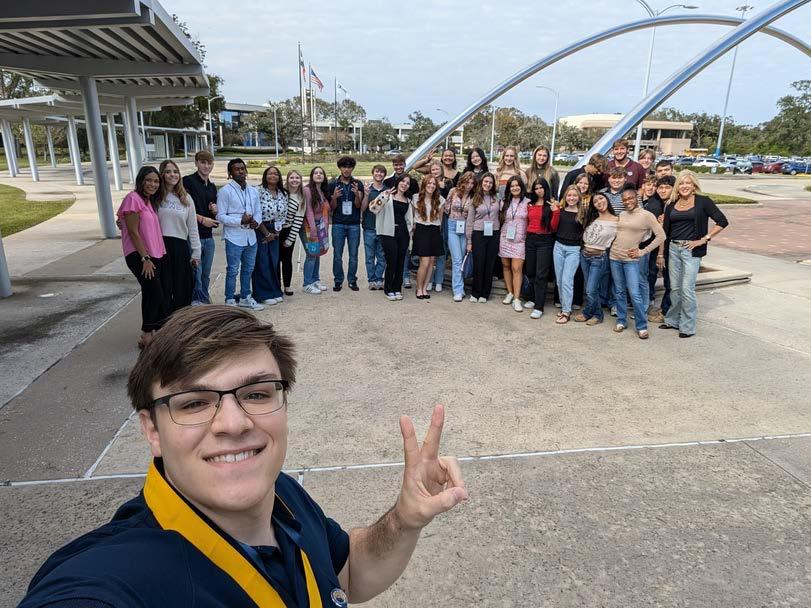


college administrators helped us improve our communication and public speaking skills, and secure financial support. Our detailed plan allowed us to pivot quickly when high school registrations were initially lower than expected. Our chapter brainstormed strategies to increase attendance, working with the dual credit department to send follow-up communication to high schools. We also extended the registration deadline and opened the Leadership Summit to Brazosport College students. Attendance grew, requiring us to activate backup plans to manage late registrations.
Collaboration was essential to the success of our project. Hosting chapter meetings throughout the year helped us practice teamwork and coordination. We reached out to college staff to mentor us on how to host a conference— something none of us had done before. Their experience helped us navigate logistics we wouldn’t have anticipated. Our chapter also worked with Ms. King, who had previously spoken at our induction ceremony and supported our work in PTK. This taught us the value of building community relationships. Overall, these skills
allowed us to successfully carry out the College Project and reach our goals.
Collaboration
Our chapter collaborated with internal stakeholders, including Dr. Solis; Vice Presidents Dr. Baucham and Ms. Wooster; career services; marketing; student life; the Student Government Association; the Black Student Union; dual credit; campus facilities; campus security; and business services. External partners included two local high schools, H-E-B (caterer), and our keynote speaker from a local nonprofit.
We primarily used email to update collaborators and high schools, confirm student participation, and address logistics. We also scheduled inperson updates to stay aligned with objectives and resolve issues proactively. Our keynote speaker was engaged through both emails and meetings, allowing us to plan her presentation in detail.
As the event approached, we increased communication to manage last-minute adjustments. Our chapter also prioritized excellent service, providing a green room for speakers, volunteers, and chaperones. During the event, we used GroupMe for real-time communication: one chat for volunteers to handle immediate needs and another for our officer team to coordinate throughout the day. This proactive approach kept collaborators informed and engaged at every stage.
Impact
The Leadership Summit welcomed 93 attendees, including 62 high school students (Figure 2). Forty received professional headshots to use for résumés, portfolios, and scholarship applications. We received 16 event survey responses; roughly 88% of attendees rated the event positively, with most giving a 4 or 5. Comments included: “how to be an example to positively influence others” and “communication is imperative.” Of the 93 surveys collected from breakout sessions, 60 students rated the sessions a 5 out of 5, with 25 rating them a 4, and 8 a 3. The chart in Figure 3 includes qualitative survey feedback.
Our chapter observed strong engagement throughout the breakout and general sessions. We received positive comments from session leaders, administrators, community members, and volunteers. High school teachers who brought students to campus also shared enthusiastic feedback, with one saying they wished such an event had existed when they were in school.
The project also strengthened our relationship with a local nonprofit. Ms. King and the True to Life Ministries staff delivered a powerful session. Though we offered a speaker fee, Ms. King declined payment. Instead, leaning into the PTK Service Hallmark, our chapter donated $1,000 to TTLM and announced this at the event to highlight the importance of servant leadership.
Beyond attendee impact, our chapter gained confidence in organizing large-scale events and built skills in event planning and logistics. This experience improved our ability to carry out future projects and left us with a strong sense of accomplishment.
Chapter–College Relationship
Our chapter met with Dr. Solis to establish the project’s direction and held follow-up meetings to ensure our efforts stayed aligned with his expectations. These conversations helped us build a working relationship and earn his trust. After the event, Dr. Solis publicly praised our chapter’s work. He recognized our College Project at a Board of Regents meeting, a College Council meeting, and in the campus newsletter. He emphasized the project’s significance, noting how it supported his leadership focus for the year and engaged the community. He also asked us to host the event again, citing its positive impact on students. His endorsement brought attention to our chapter’s accomplishments.
Collaborating with college staff and administrators strengthened our professionalism and gave us insight into their roles. Working with the venue coordinator helped us understand the college’s infrastructure and how to navigate it for future events. This project deepened our chapter’s relationship with the college and broadened our understanding of institutional resources, equipping us to serve our community more effectively.
Breakout Session SurveyRatings and Feedback
Quantitative:
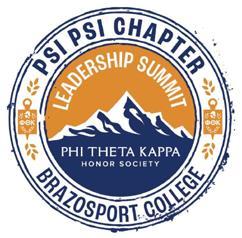

Qualitative:
Students left survey comments to Breakout Leaders such as:
● “Mr English is an amazing speaker and just a joy to engage with”
Students learned lessons such as:
● “Practice and listen to others in order to be a well rounded leader”
● “Be confident within your own decisions regarding your future”
● Leadership is bringing people up much more than directing people
Figure 3
Increasing AI Literacy Among Community College Students
Beta Theta Kappa Chapter Butte College
Oroville, California
Abstract
Generative artificial intelligence (GenAI) is rapidly changing the educational and workplace landscape. The Beta Theta Kappa Chapter of Phi Theta Kappa’s (PTK) College Project seeks to enhance AI literacy among students by developing and leading studentcentered workshops to provide hands-on experience with AI systems; hosting invited guest speakers to share their expertise with students; and assessing the overall effectiveness of these activities in increasing students’ knowledge and use of AI systems in educational settings.
The workshops were developed to support Butte College’s mission as outlined in the Strategic Plan 2024–2027. One of the four foundations listed in the mission statement is technological innovation. Specifically, Objective 2.4 states that the college will “explore ways to improve student experience with the use of generative AI as well as smart analytics to data systems.” By providing students with hands-on training in the ethical use of GenAI technologies, our workshops ensure that Butte College fulfills its mission by active engagement with emerging technological innovations that directly affect education.
In addition, our PTK officers developed leadership and teaching experience and increased collaborations in and outside of our college. Our chapter collaborated with staff and faculty at the Center for Academic Success (CAS), including Cory Gruber and Tina Day. CAS provided a general framework for workshop development, scheduling, advertising, and participant tracking. In addition, PTK officers hosted talks by faculty member Jason Trento and local business owner Anika Burke of Chico, CA, both of whom addressed the use of GenAI in and outside of the classroom.
Finally, we established a long-term collaboration with Chico State University to apply for grants through the California Learning Labs to increase access to these technologies in our rural communities (in partnership with Zach Justice, Chico State University). Our postworkshop survey revealed an increase in student AI literacy: students felt more knowledgeable, gained
practical skills, felt less anxious, and were more likely to use these systems in a productive and ethical way in the classroom.
Planning
Initial planning in February involved officers brainstorming potential ideas. We focused on three feasible projects aligned with the college mission statement. The PTK chapter president scheduled a meeting with the college president, Verginia Guleff.
In April, officers met with the college president to develop the College Project. Chapter members first presented on AI in education, which was approved, as this project corresponded well to the college mission and ongoing work of a faculty task force on AI. The president suggested we consult with CAS (our college’s tutoring center) to develop and offer our workshops on AI.
In May, the officers met with CAS faculty to discuss workshop development. Each workshop would align with CAS standards and would include a lecture, a discussion, an activity, and an assessment for each 50-minute workshop. As our goal was to offer studentled workshops, CAS agreed that the first offering could be jointly given by the advisor and participating officers with subsequent offerings led by officers themselves. In August, we met with CAS to schedule workshops. We offered workshops weekly, either at the main campus or at a satellite center. Special sessions were offered on Fridays at the main campus to serve student athletes.
In addition, we met with faculty from Chico State to discuss a collaboration aimed at increasing AI technology access across the region.
In the summer, we developed workshops, trained officers, and created a survey.
Leadership Development
Officers used their knowledge and skills in planning, communication, and research in the development of the College Project. The year-long College Project required officers to strategically plan the shape of the project from early on. Officers had to effectively communicate among themselves and others, particularly during our meeting with the college president, to pitch their ideas. Pre-meeting pitch practice ensured that all officers were prepared for this session. In addition, officers utilized email to communicate and schedule meetings with others, including college faculty, administration, staff, and outside collaborators.
Two officers strengthened their communication skills by leading multiple AI workshops throughout the semester. Both officers relayed to the advisor their increasing confidence in public speaking and teaching after the first few sessions.
The development of our proposed and final College Project required a significant amount of research, organization, and time management. Officers consulted books, articles, websites, and other sources to educate themselves on the various topics; this knowledge helped them to develop the workshops implemented during the project. A list of primary resources for workshop development can be found under References. Further, officers strengthened their writing, editing, and data analysis skills throughout the project.
References
Khan, S. (2024). Brave new words: How AI will revolutionize education (and why that’s a good thing). Viking.
Shah, P. (2023). AI and the future of education: Teaching in the age of artificial intelligence. John Wiley & Sons.
Mollick, E. R., & Mollick, L. (2023). Assigning AI: Seven approaches for students, with prompts (The Wharton School Research Paper). https://doi. org/10.2139/ssrn.4475995
Mollick, L., & Mollick, E. (2024). Updated tutoring prompt. More Useful Things. https://www. moreusefulthings.com/student-exercises
Collaboration
We developed three workshops to facilitate learning and discussion around AI integration in education: AI 101: An Introduction to Generative AI; AI as a Personal Tutor; and Ethical Considerations of AI in Education. We offered each workshop weekly throughout the fall semester at the main campus and at a satellite center (Chico Center).
Officers led each workshop. Participating students received an outline of the lecture, discussion prompts, detailed instructions on the activity, and assessment questions with a QR code to participate in a postworkshop survey. The activities included: how to craft an effective AI prompt, how to prompt GenAI to become a personal tutor, and how and how not to use AI in the classroom.
We hosted two speakers who shared their expertise with our students. Jason Trento (Physics, Butte College) gave the keynote talk at our PTK spring induction entitled “Empowering Education: The Role

of AI in Enhancing Academic Success” on May 9, 2024. A local business owner, Anika Burke, discussed how she utilizes AI in her business functions.
Our collaborators included members of CAS, facilities, faculty, and other experts on November 20, 2024. We communicated over email and Zoom. Prior to each invited talk, the officers contacted collaborators and planned their appearance. They also contacted facilities management and food services to schedule rooms, equipment, and food. The team expressed gratitude to our collaborators through certificates of appreciation and a gift card.
Impact
Twenty workshop participants completed our AI in Education survey (https://www.surveymonkey. com/r/KVQJ9TW). The workshops were highly rated, receiving 4.8 out of 5 possible stars. Our participants reflect the demographics of our school based on gender (65% female), ethnicity (35% Hispanic, 30% white, 18% Black), and age (59% ages 18–24). The majority (65%) had little to no experience with GenAI, with 35% reporting they had never used these technologies before.
Afterwards, participants reported a number of positive outcomes:
• They are now more aware of the generative AI tools available to assist them in their education (93% agree or strongly agree)
• They gained practical skills of using AI in an academic setting (100%)
• They are more aware of the ethical issues surrounding AI use in education (100%)
• 90% feel less anxious about AI technologies after taking the workshops
These results support our aim to increase AI literacy among our students. Our workshops improve
students’ experience with the use of generative AI, aligning with the college’s Strategic Plan 2024–2027 Objective 2.4.
Further, our project strengthened ties between our chapter and the college. First, by offering studentled workshops, PTK visibility on campus increased. Second, workshops were well attended and received. CAS requested we continue to offer our workshops as they address a high-demand topic area. Continuing to offer workshops offers a way to continue our engagement with the college, support its mission, and provide PTK students a unique opportunity to gain valuable skills. And third, we established working relationships with community and local university members.
Chapter–College Relationship
Our initial meeting with the college president established an opening for PTK officers and a new PTK advisor to introduce themselves. This initial meeting demonstrated that our students were eager to assist the college and gave names and faces to our chapter officers. This otherwise small component of our meeting showed its influence when, later in the fall semester, our college president recognized our chapter president at an outside event. The two discussed the various projects of the chapter, including the Honors in Action Project. As part of that project, our chapter president invited the college president to speak at an organized event and the college president gratefully accepted the invitation.
In addition, our officers learned to effectively communicate with college officials. For example, our chapter president contacted the vice president of elections and appointments who helped organize a planning committee for a PTK event, reviewed survey questions, and offered recommendations for changes, which we utilized.
Our students also established working relationships with the members of CAS, including offers to two of our students for tutoring positions to continue these workshops. For our College Project, officers led workshops without any outside compensation. With our connection with CAS, we may have a pathway for our members to engage in paid tutoring for other students through CAS.
Finally, the officers and advisor met with the college president to provide an update on the College Project, demonstrating our commitment to the project, the school, and increasing AI literacy among our students.
S.O.S. – Serving Our Students Through Sexual Health Education and Free Safe Sex Supplies
Alpha Beta Iota Chapter
Walters State Community College
Morristown, Tennessee
Abstract
The 2024 Alpha Beta Iota College Project, S.O.S. – Serving Our Students Through Sexual Health Education and Free Safe Sex Supplies, has greatly contributed to fulfilling Walters State Community College’s (WSCC) mission of “fostering a welcoming campus community through cultural awareness and open dialogue.” It will continue to support the college’s goal of “transforming our community through education” and mission “to provide resources to support community engagement and initiatives” through our collaborative partnership with the Tennessee Department of Health for years to come.
Our college’s service area is currently listed as one of the top ten hotspots in the United States for syphilis infections. Syphilis is a sexually transmitted infection (STI) caused by the bacterium Treponema pallidum that can affect multiple organ systems and cause death. The best practice for both physical and mental health is to prevent infection. The best way to prevent STIs is through education— spreading awareness and promoting open discussion—which aligns directly with our college’s mission statement. Using safe sex prophylactics is the next-best practice after abstinence, but they are cost-prohibitive for many college students. Our 2024 College Project is a collaborative effort with the Tennessee Department of Health to help prevent the spread of STIs by providing free condoms and educational resources on every Walters State campus.
Planning
After thoroughly reviewing WSCC’s goal and mission statements, the Alpha Beta Iota Chapter
of Phi Theta Kappa initially spoke with college administrators in February 2024 about a campus need we could address together. Although administrators had a few suggestions, they truly wanted to hear the students’ voices and insisted that PTK members determine a student need that aligned with WSCC’s goals and mission. PTK officers had prepared a few College Project suggestions, but we all agreed to remain flexible by researching further student needs and revisiting the discussion the following month.
Following that meeting, chapter officers surveyed several student groups. We found that mental health, physical health, and financial stability were the top priorities for our student demographic. Based on those findings, we explored state education priorities and identified the Tennessee Department of Mental Health and Substance Abuse Services’ Coalition for Healthy and Safe Campus Communities (CHASCo). CHASCo collaborates with Tennessee colleges to provide resources, funding, professional development, and assessment tools to foster a healthy and safe learning environment.
Building on CHASCo research and additional resources from the Tennessee Department of Health, we considered available funding and supplies and developed several additional project ideas to present to administrators.
The planning process took more than four months and involved half a dozen meetings with the college president, vice presidents, deans, and other campus leaders before we mutually decided to proceed with S.O.S. – Serving Our Students Through Sexual Health Education and Free Safe Sex Supplies. However, we were still not cleared to begin. The WSCC vice president of academic affairs represented our chapter at the Vice Presidents’ Council and the President’s Executive Committee to obtain final approval before implementation could begin.
Leadership Development
Our chapter members and officers had minimal experience researching public health initiatives, so we created a strategic plan to address this challenge. Although the PTK Research Edge and Healthcare Edge leadership development programs are designed to support Honors in Action and healthcare career pathways, they were
a great starting point for strengthening critical thinking skills. The PTK Research Edge learning outcomes served as our guide as we developed our leadership mindset.
As our research knowledge expanded, we found our skills and interests aligned well with organizing the project. Some members honed their presentation skills for pitching ideas to administrators, while others focused on effective communication strategies for follow-ups and scheduling meetings with Tennessee Department of Health managers across multiple counties in our service area.
The Healthcare Edge program was a fantastic resource for strengthening time management, teamwork, and empathetic thinking, while reinforcing the importance of physical and mental self-care.
We also assessed our progress and realized many PTK members had not received formal sex education in middle school, high school,

1
Figure
or college. Fortunately, we found a WSCC microbiology professor with a background in reproductive medicine who offered supplementary lessons in sex education, STIs, and available treatments.
Collaboration
The Healthcare Edge program also led us to carefully consider the importance of recipient confidentiality when placing condom dispensers and educational resources. Although demand was high, obtaining supplies could be embarrassing for students. We decided that placing dispensers in both male and female restrooms was the most discreet option.
This decision doubled the number of dispensers needed across WSCC’s five campuses and created funding challenges. The wall-mounted dispensers (Figure 1) cost more than $300 each. We worked with each campus’s administration and staff to identify appropriate locations, which were submitted for review by the Vice Presidents’ Council and the President’s Executive Committee. The vice president of student affairs served as our liaison throughout the process.
Once approved, we partnered with campus staff— including service learners, natural sciences lab coordinators, and student pantry workers—for storage and restocking of supplies alongside PTK volunteers.
The Tennessee Department of Health holds a long-term grant to distribute free condoms and a limited number of dispensers across the state to combat the growing syphilis epidemic. However, different counties have different managers and contact people, which created a scheduling challenge and required flexibility from our chapter. That same complexity turned out to be an asset: the multi-county reach allowed us to obtain two dispensers per campus. Through creative networking and communication, we obtained all ten dispensers at no cost and secured more than 15,000 premium condoms, successfully launching the project on every campus by the first day of school.
To promote the project and related service events, chapter members worked with the WSCC public relations office, student activity calendar, and eLearn platform. We also set up informational
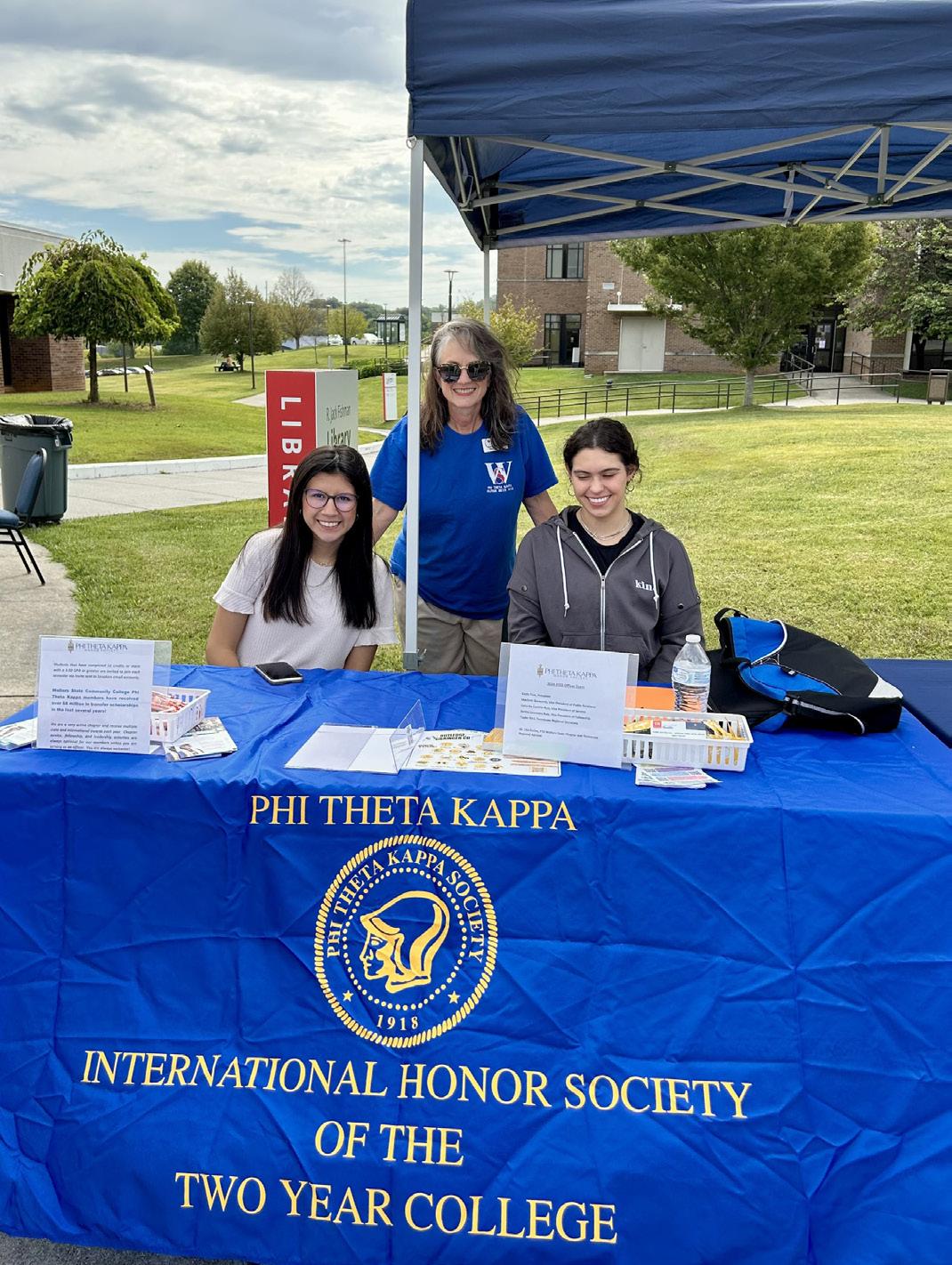
We did face a few unexpected obstacles. Our service area is part of a very conservative “Bible Belt” region, and some staff and administrators objected to the project, believing it encouraged promiscuity. This objection highlighted the lack of sex education available to many students and presented a significant challenge. In response, we adjusted our language—referring to items as “health supplies”—and relied on the support of key administrators, especially the vice president of student affairs.
We also partnered with community healthcare professionals and mental health counselors to provide additional educational events and free resources (Figure 3). Their support validated the project’s purpose, and we addressed these challenges in our final report to the college, which was met with strong praise.
PTK tables (Figure 2). Still, word of mouth traveled quickly.
Figure 2

Impact
The 2024 Alpha Beta Iota College Project, S.O.S. – Serving Our Students Through Sexual Health Education and Free Safe Sex Supplies, has been a major success. So far, we have distributed more than 15,000 free premium condoms—valued at over $35,000—and connected with more than 4,500 individuals through education and supplies.
We have strengthened WSCC’s mission of fostering a welcoming campus community through cultural awareness and open dialogue. And we will continue to support the college’s mission and goal of transforming the community through education by partnering with the Tennessee Department of Health for years to come.
Chapter–College Relationship
This College Project strengthened our relationship with WSCC administration through ongoing collaboration and support. We gained a deeper understanding of how to work together and built lasting connections with multiple campus leaders.
Chapter members developed new skills, served others in meaningful ways, experienced leadership firsthand, and strengthened relationships with campus groups and departments. This project not only expanded our chapter’s reach—it also created meaningful impact that will continue to save lives.
Figure 3


